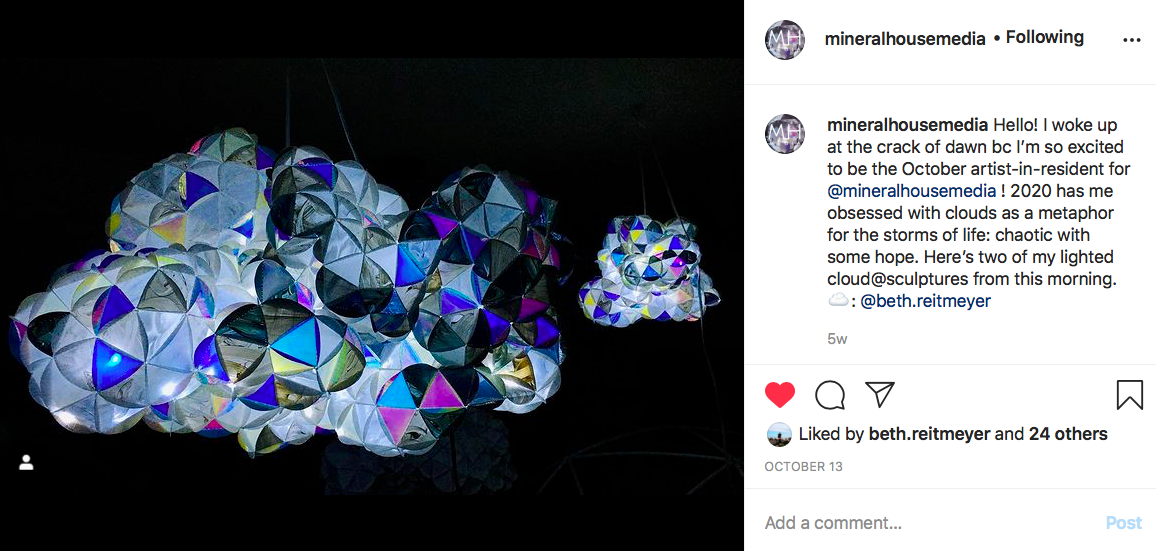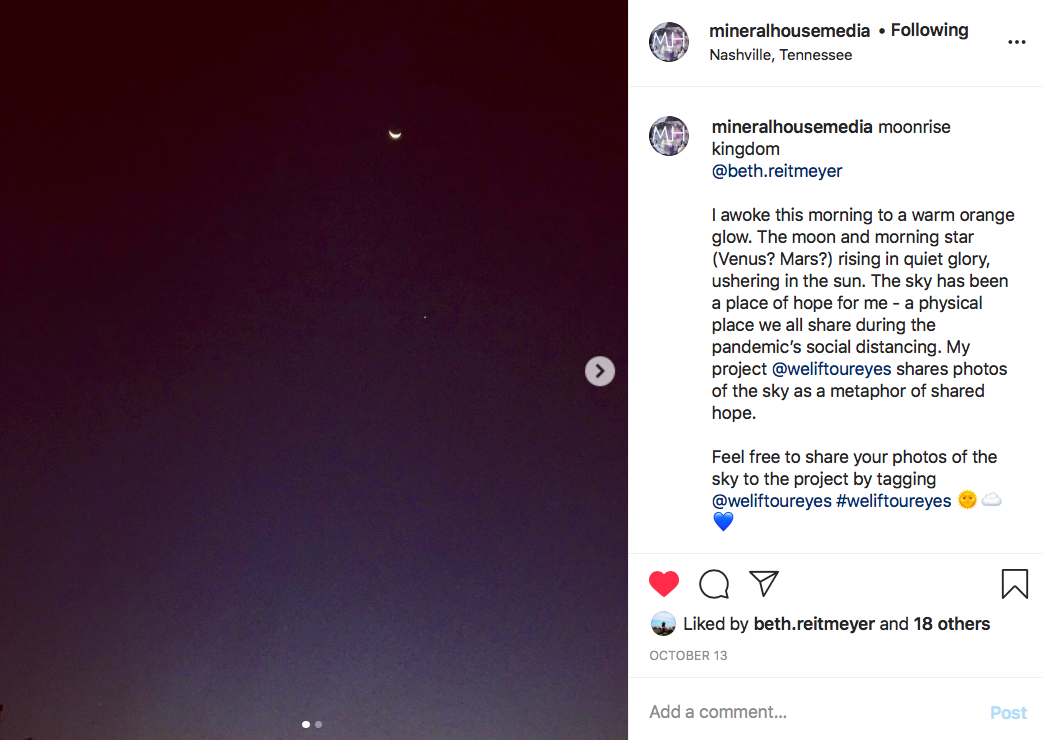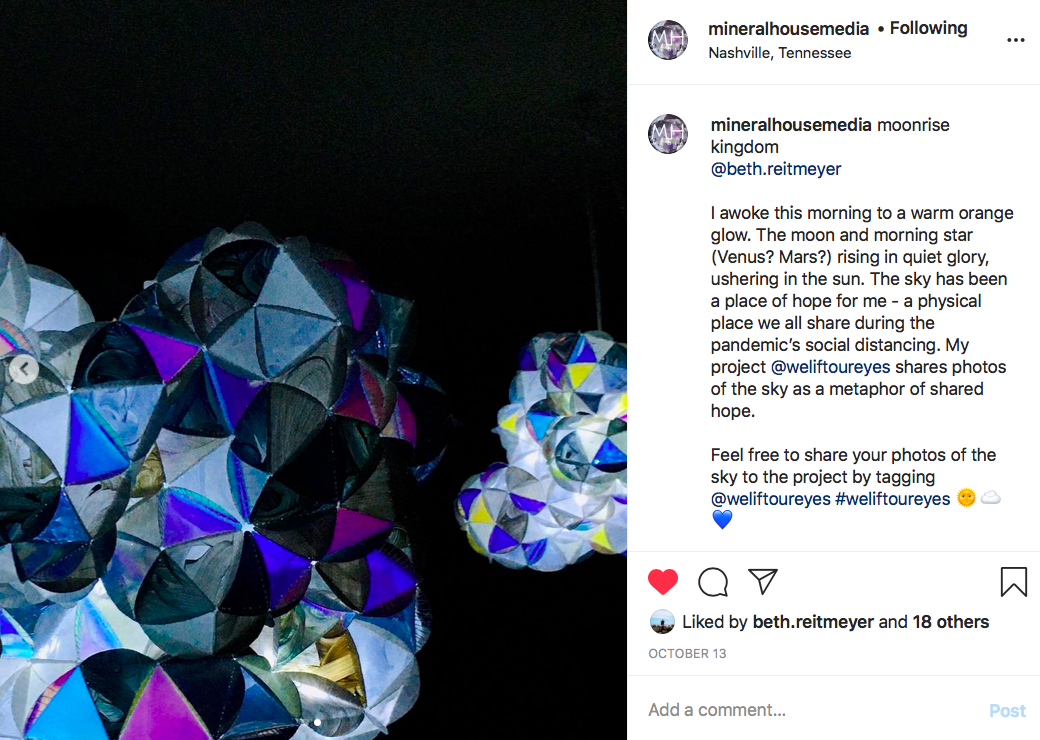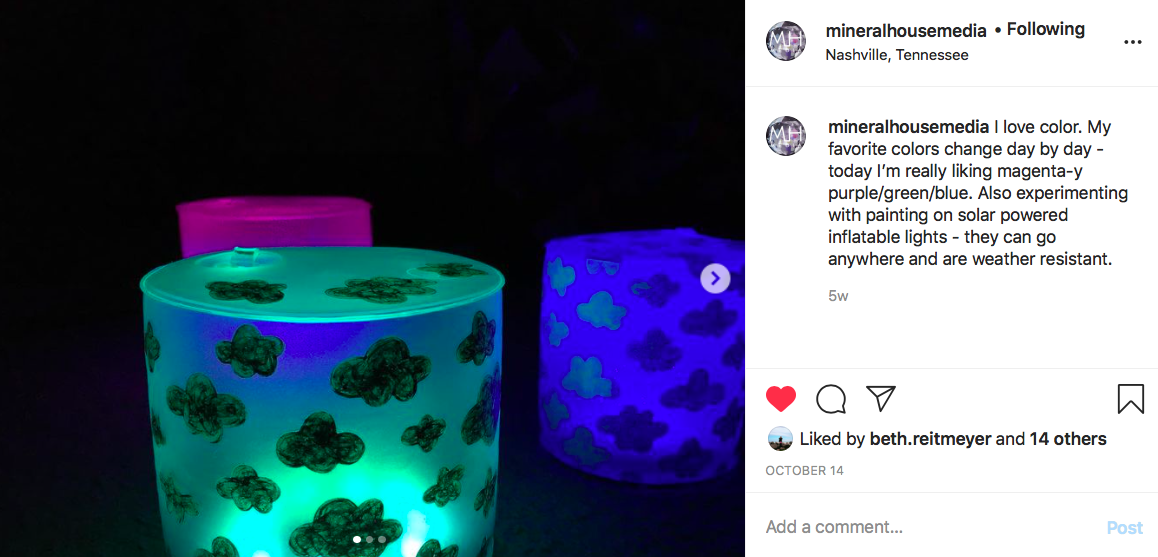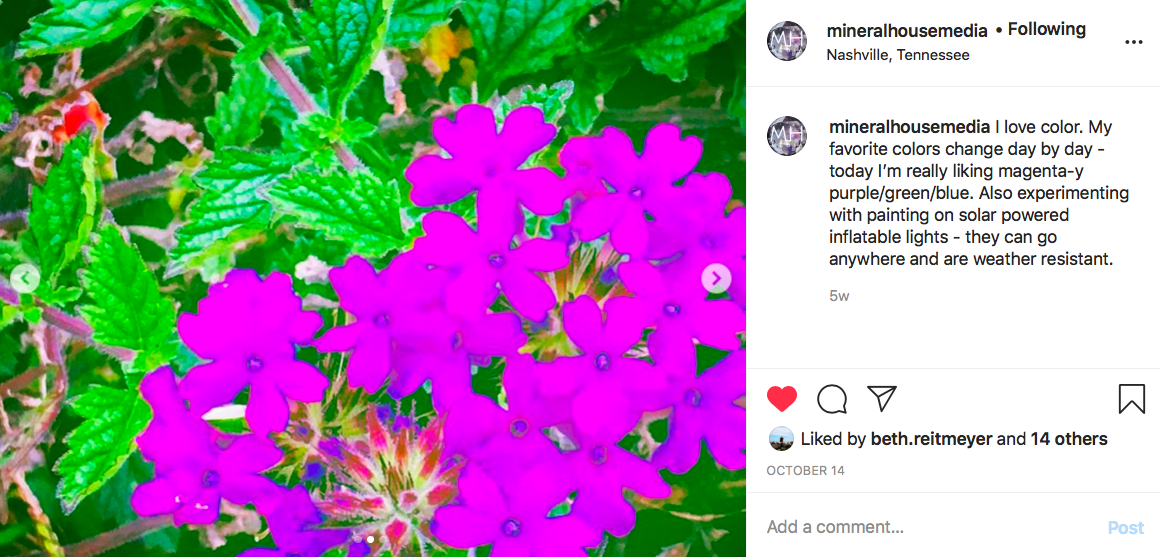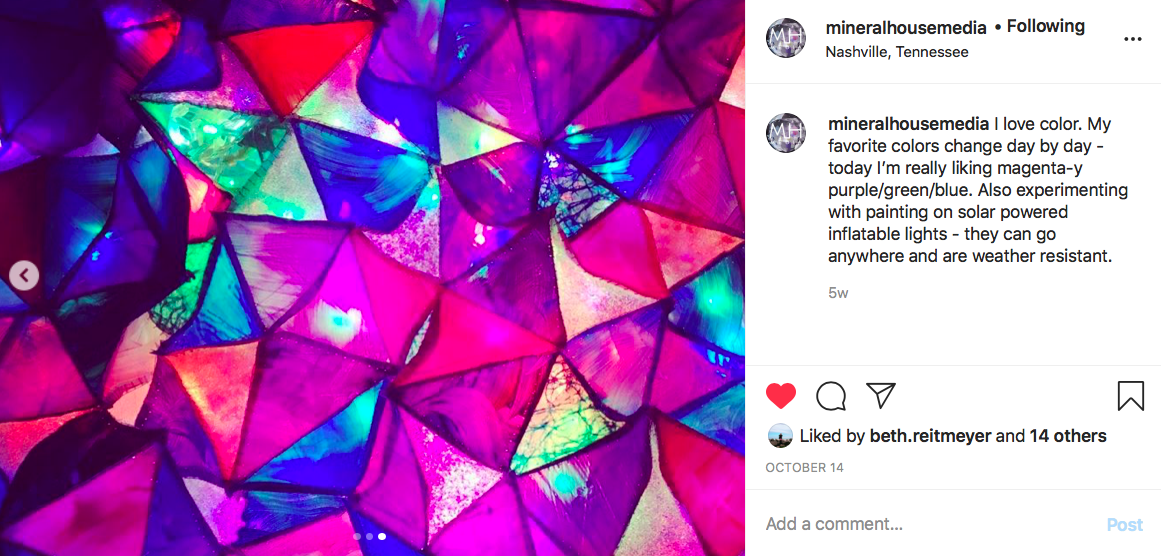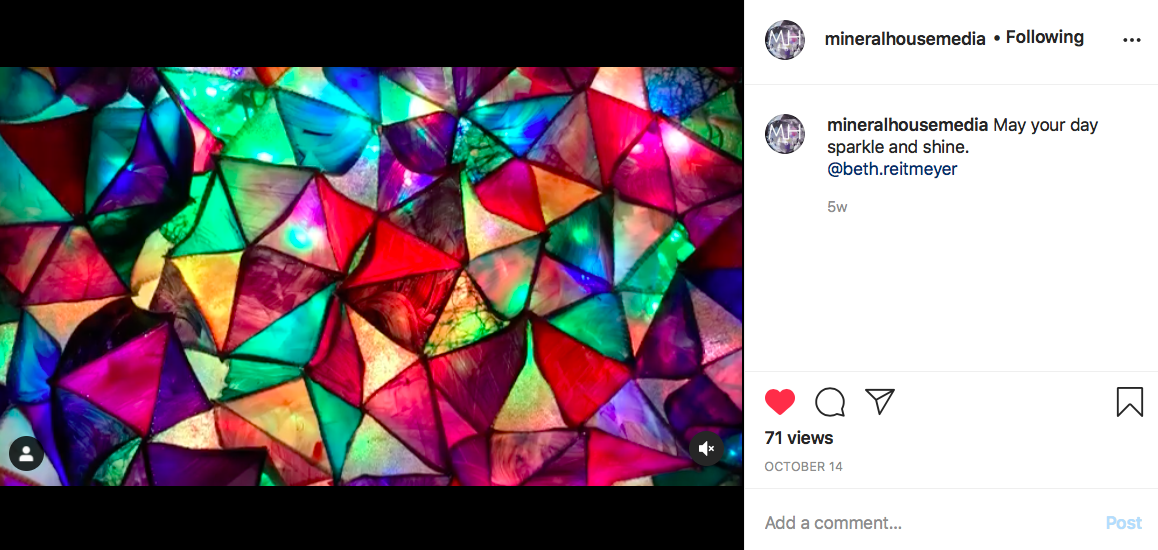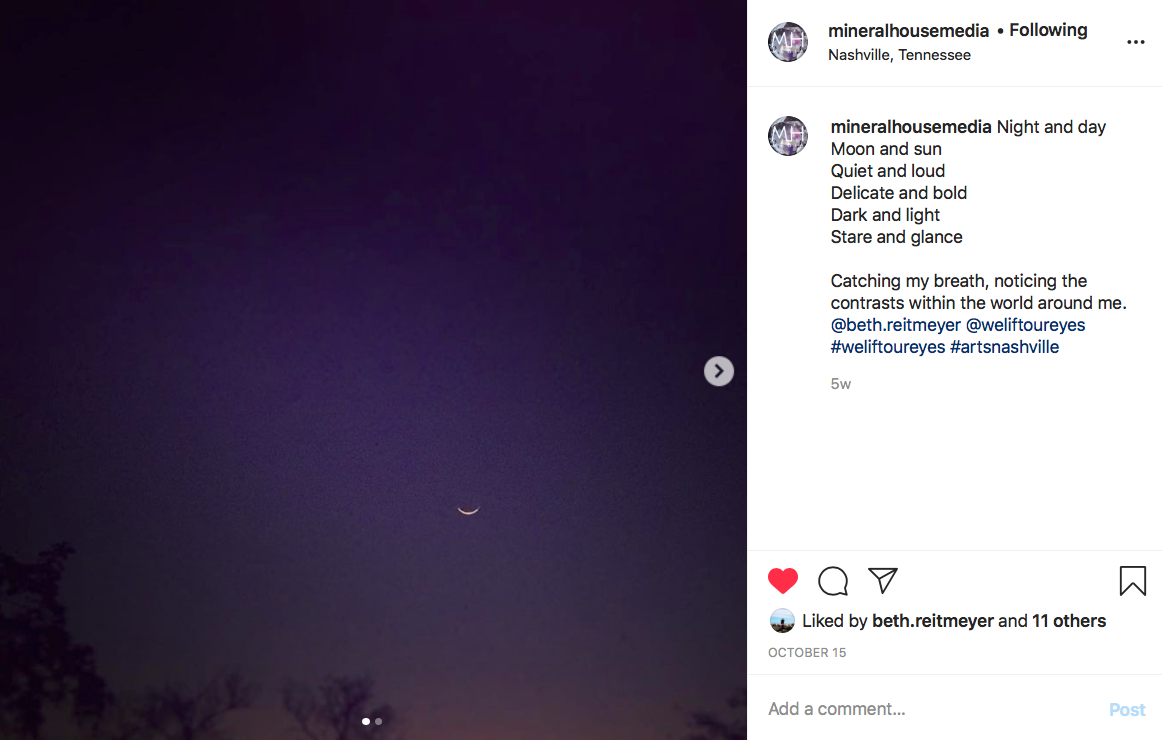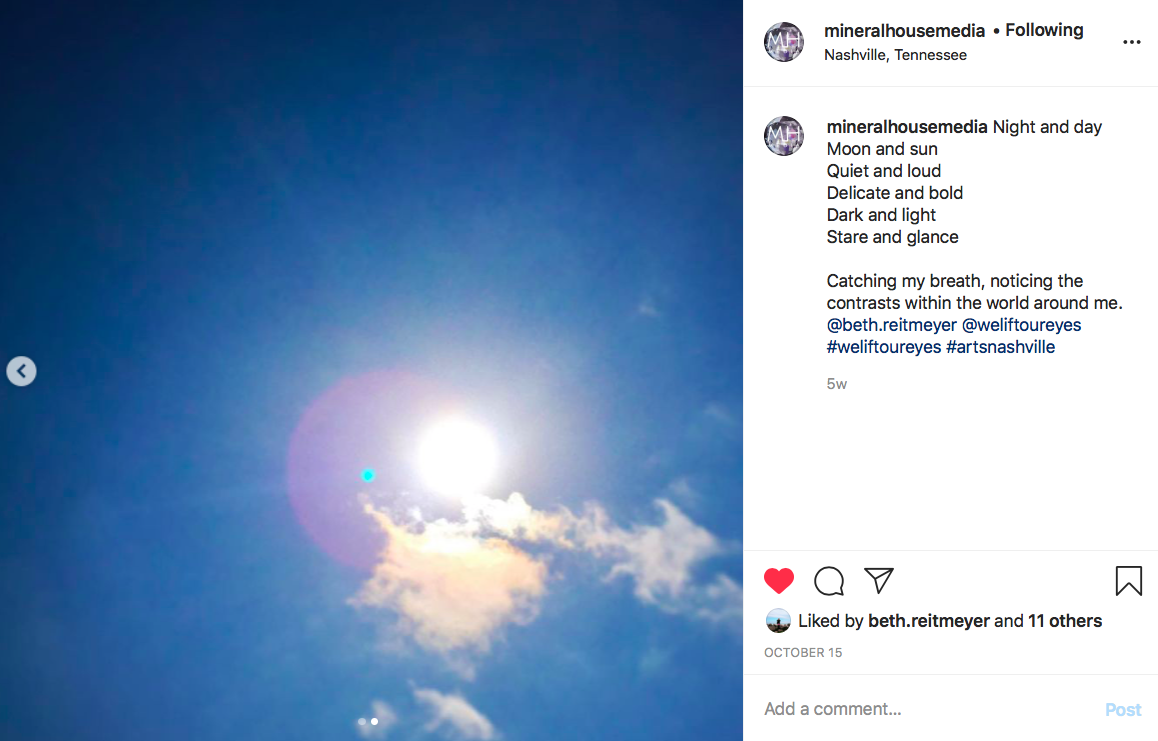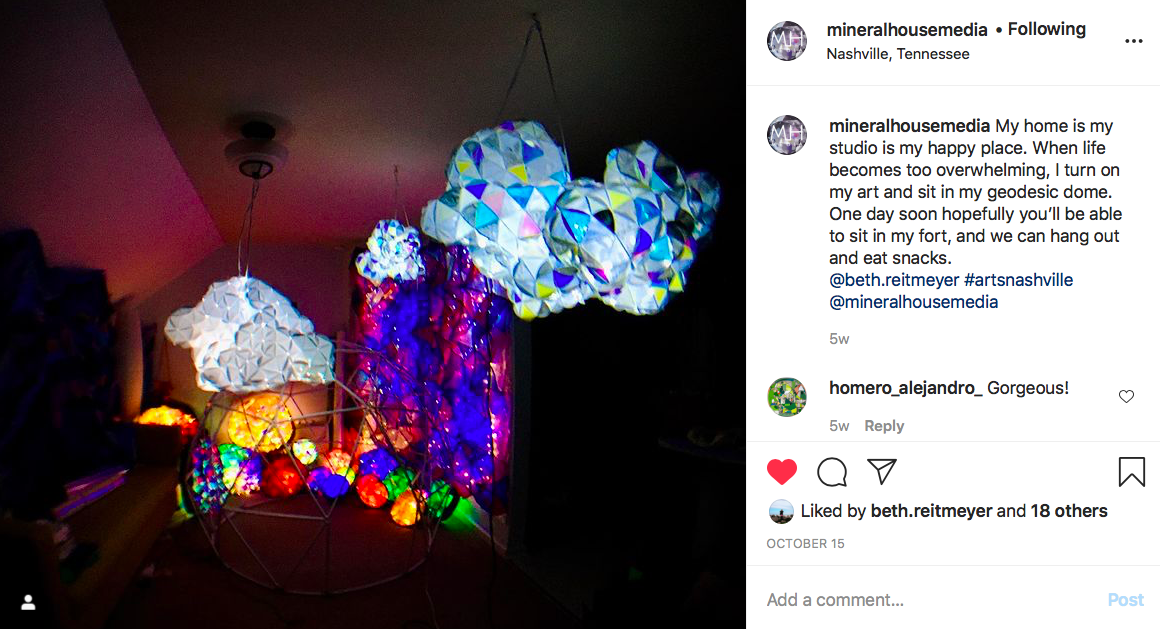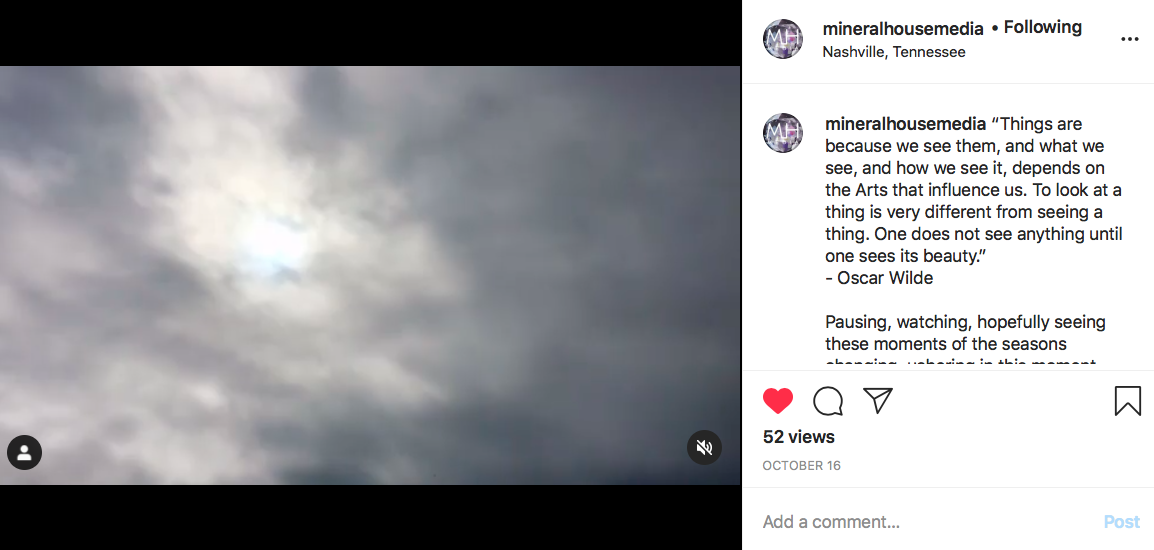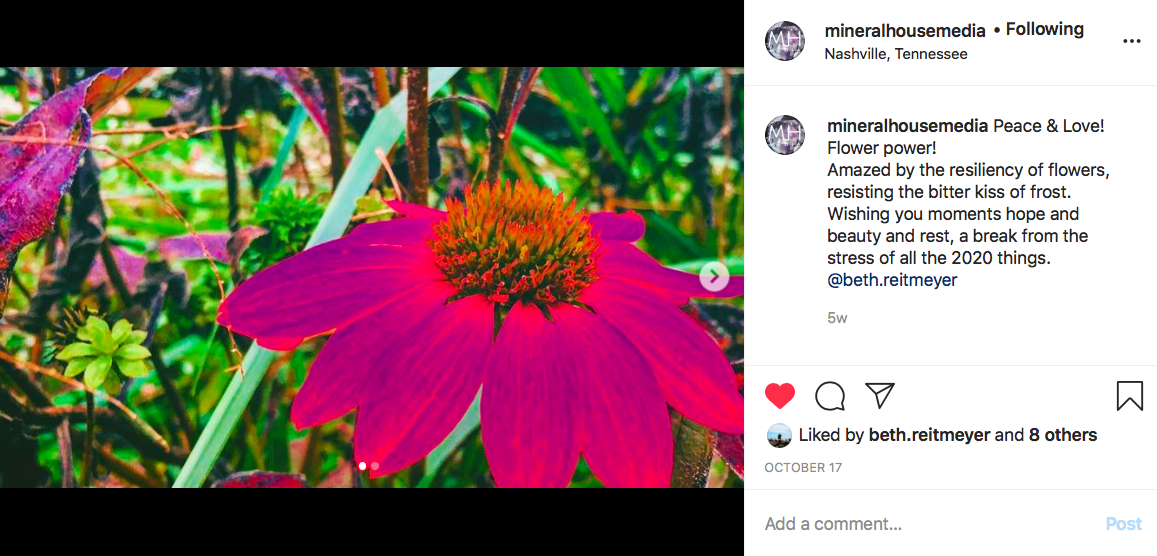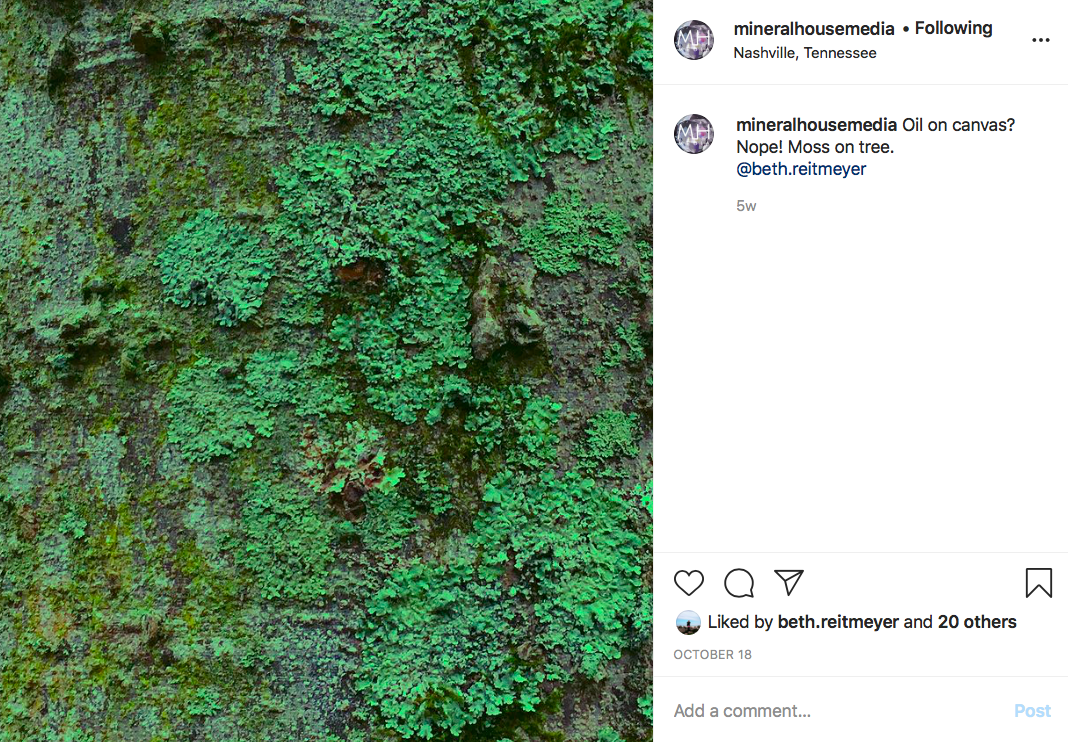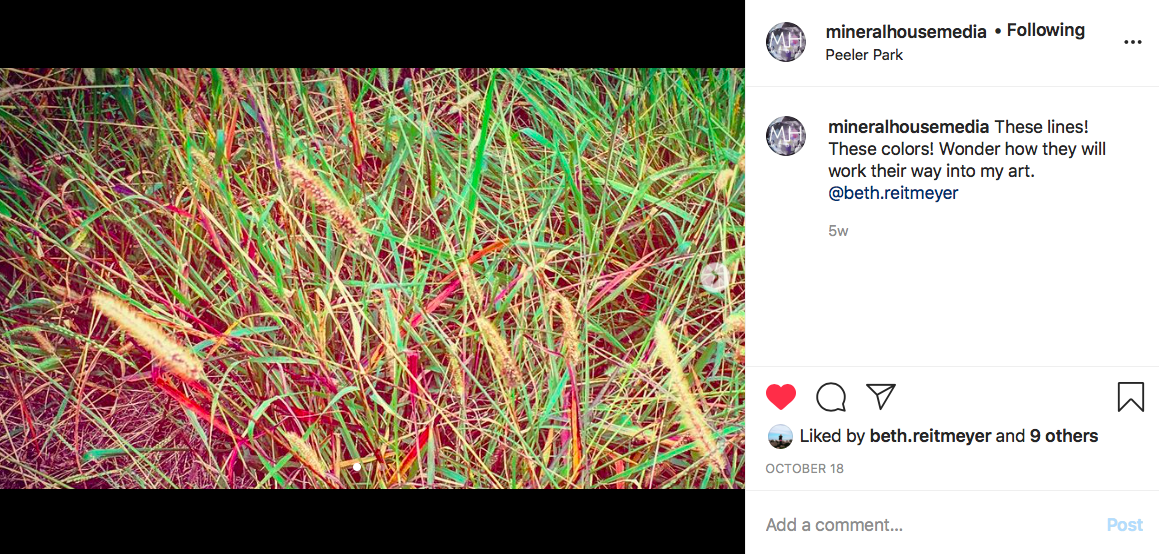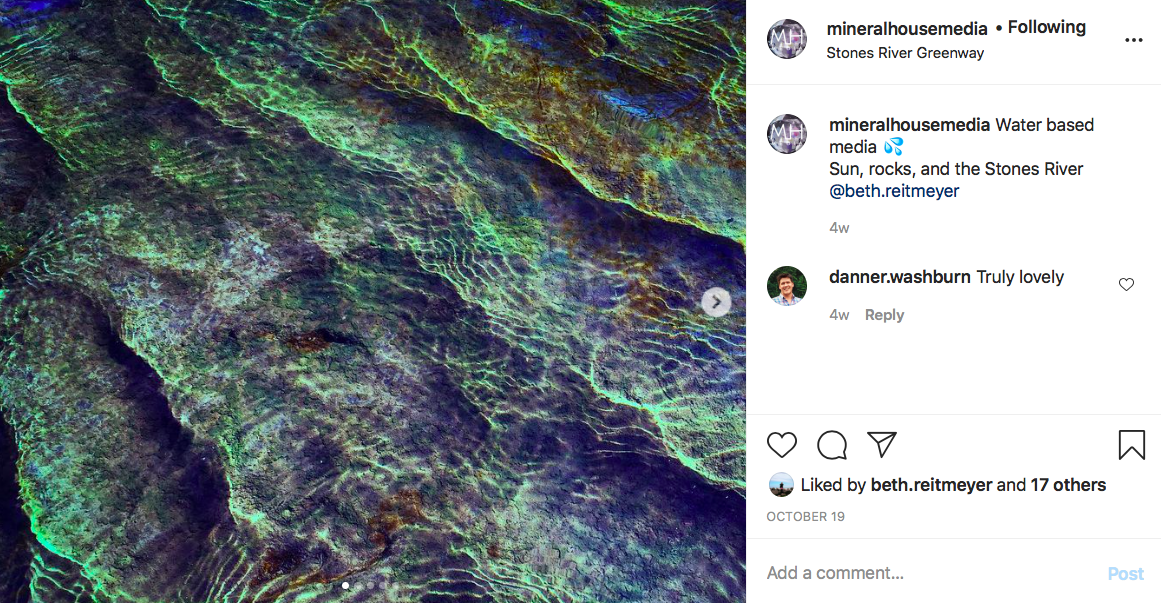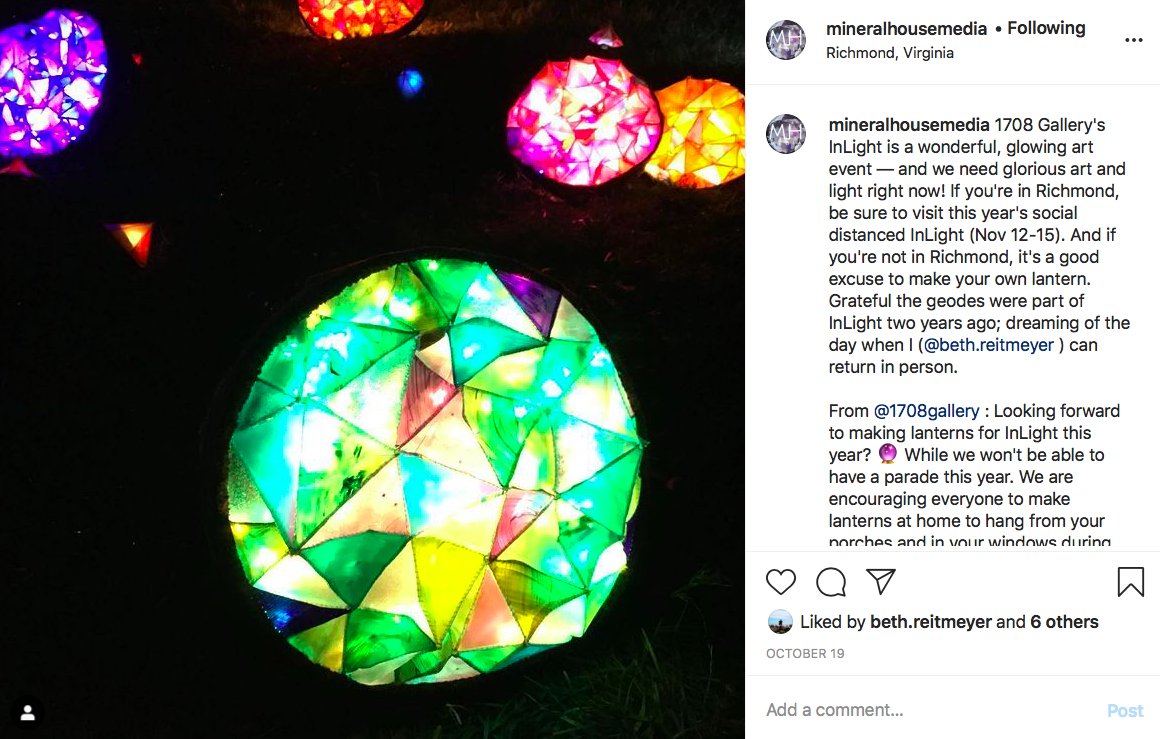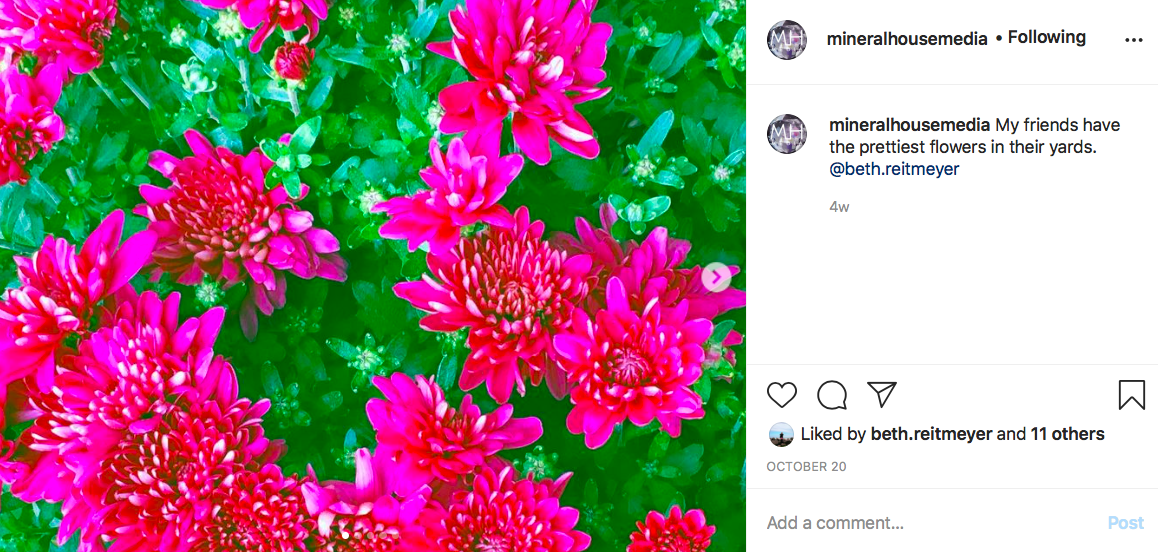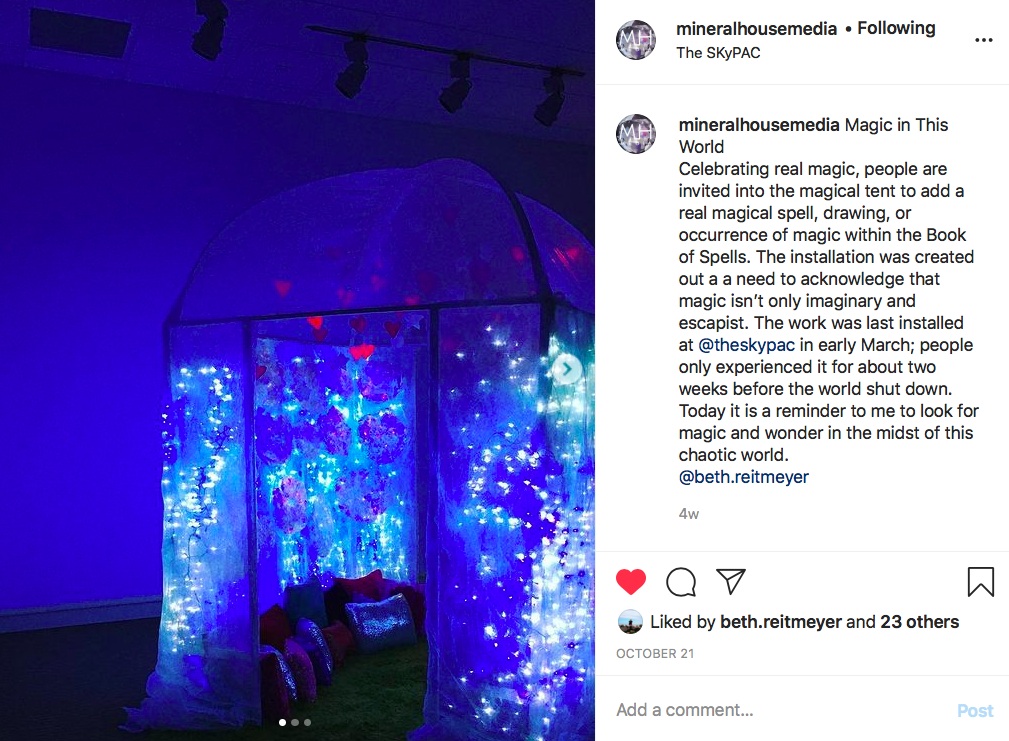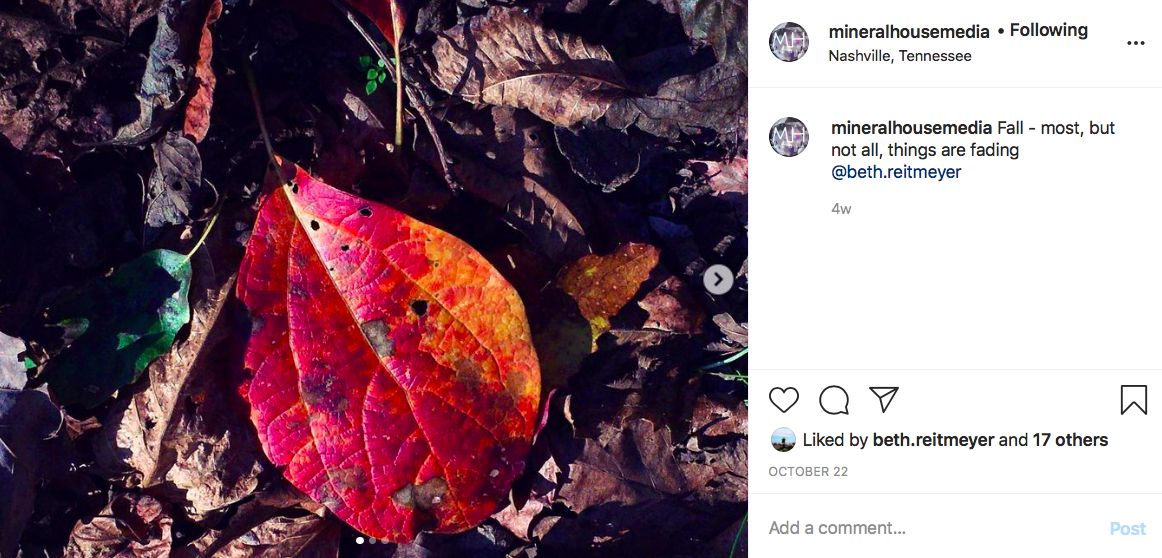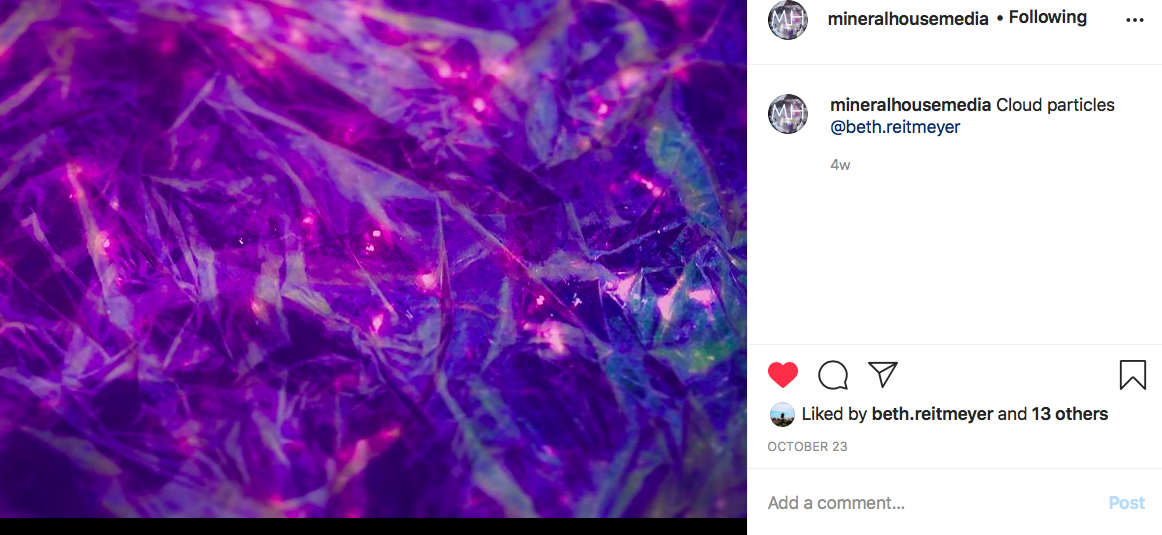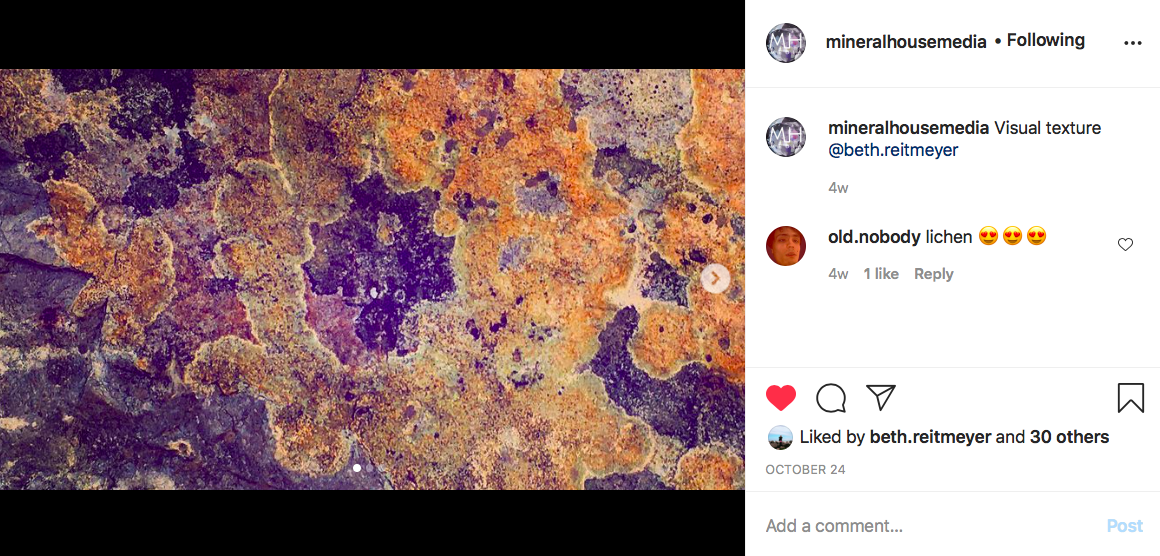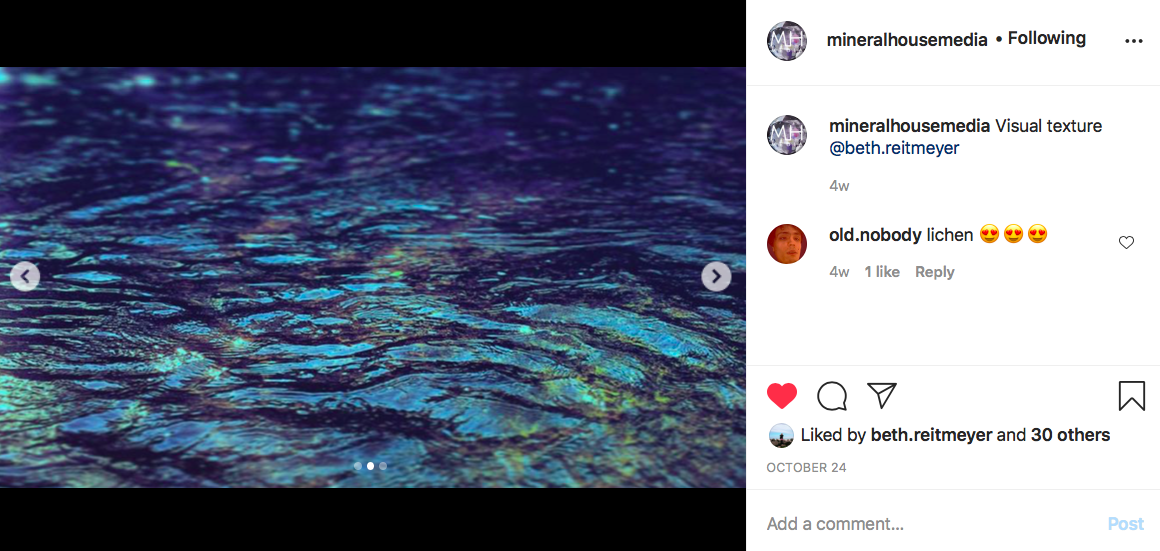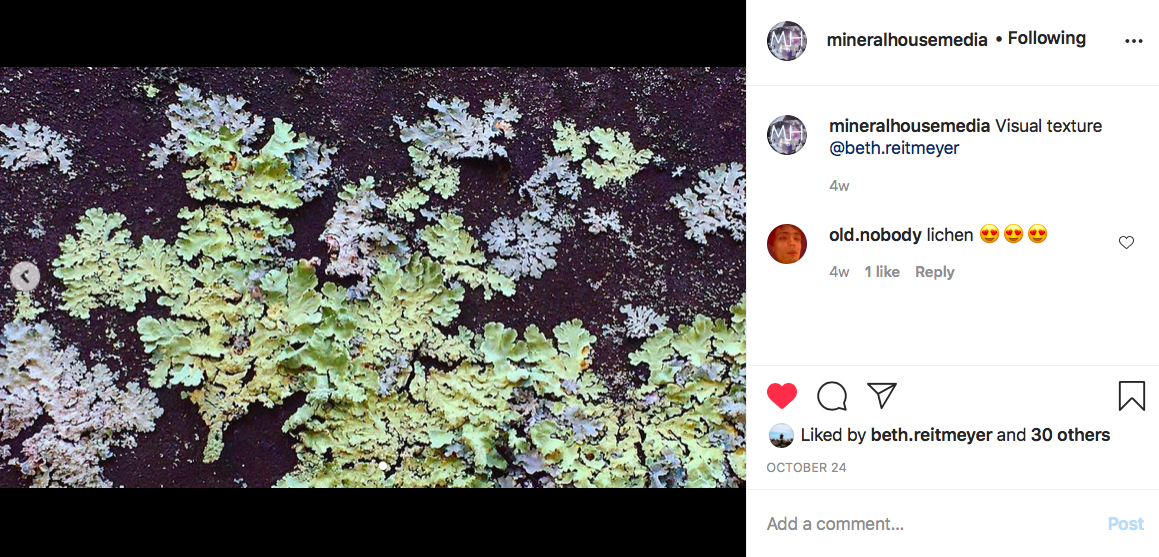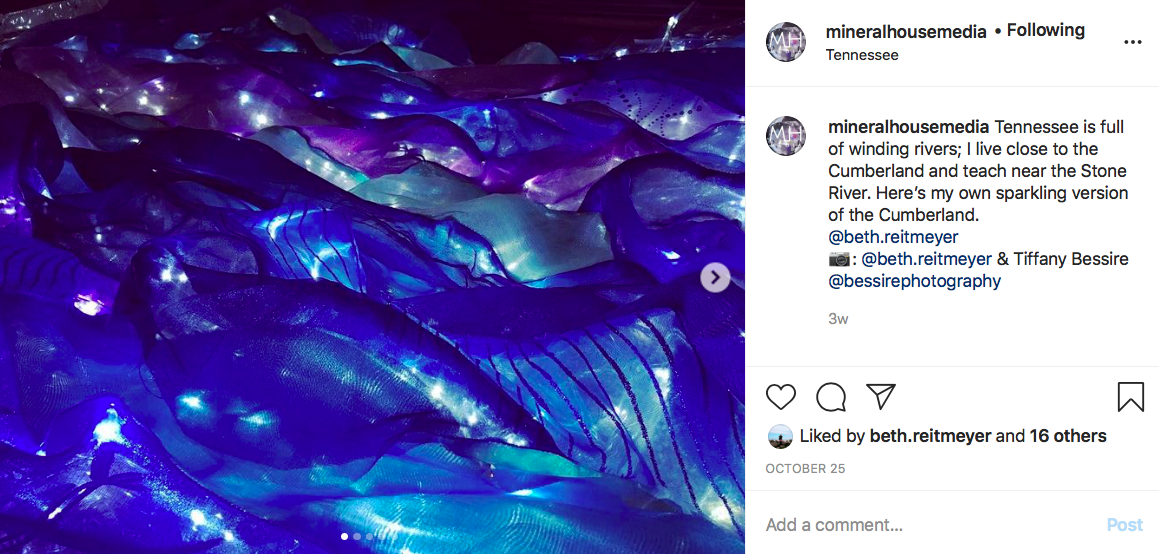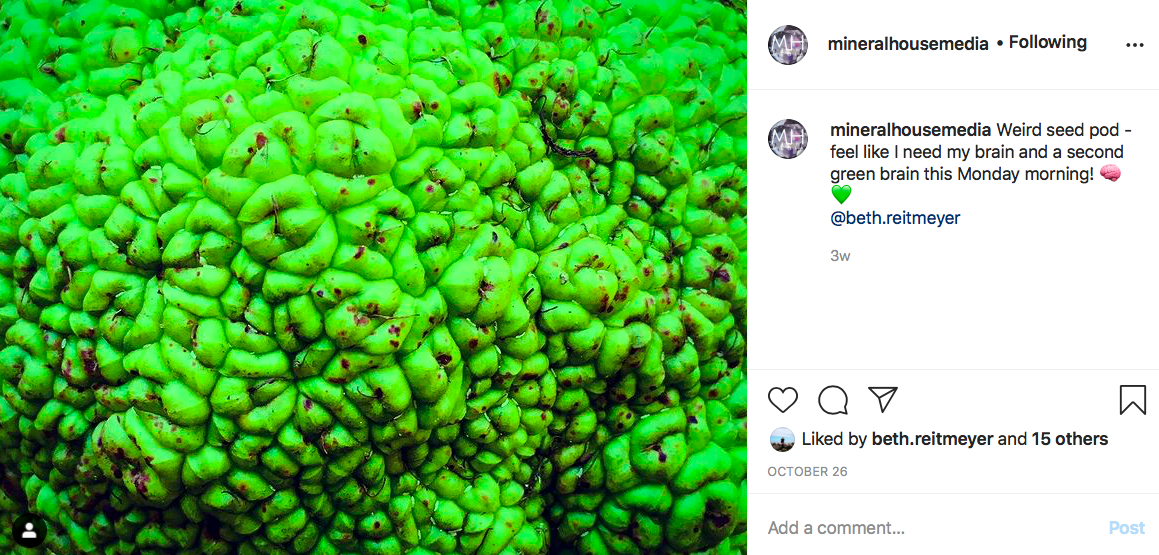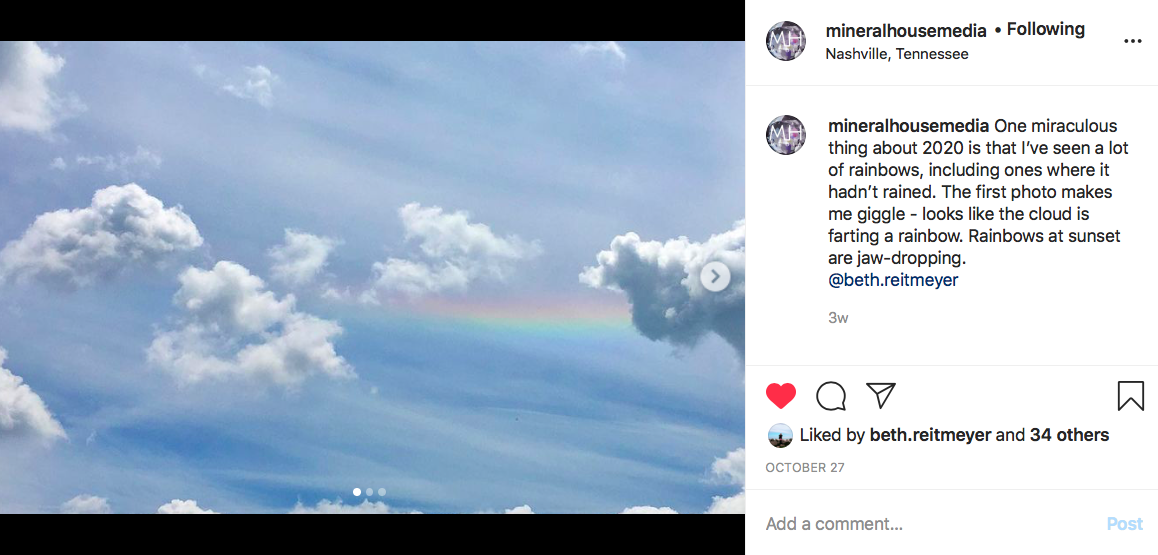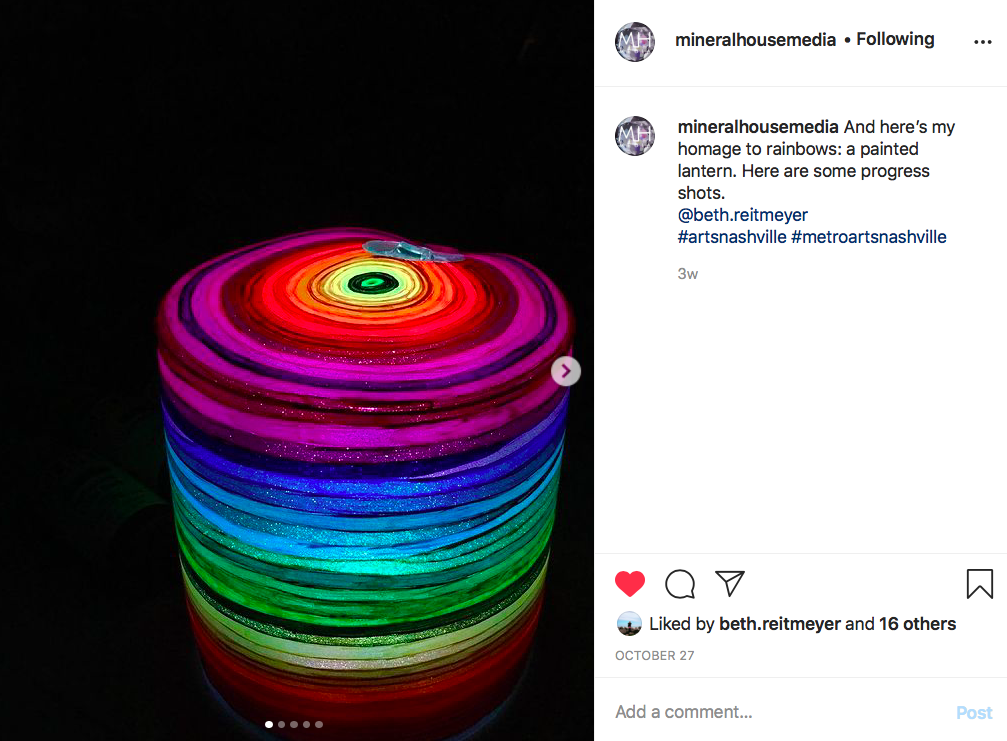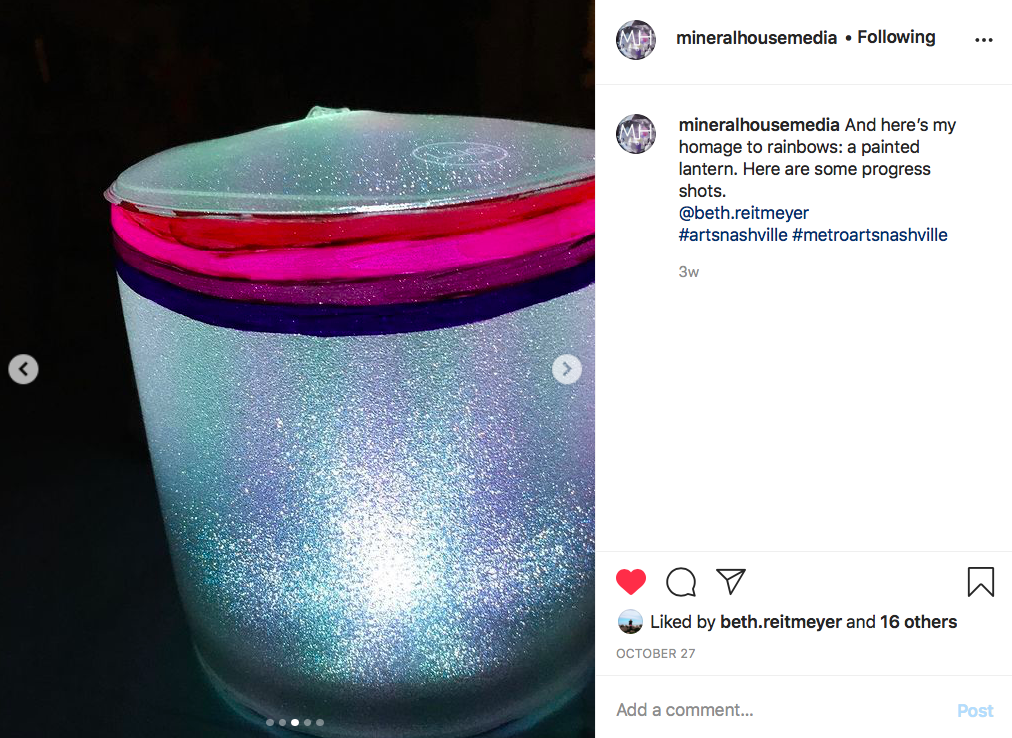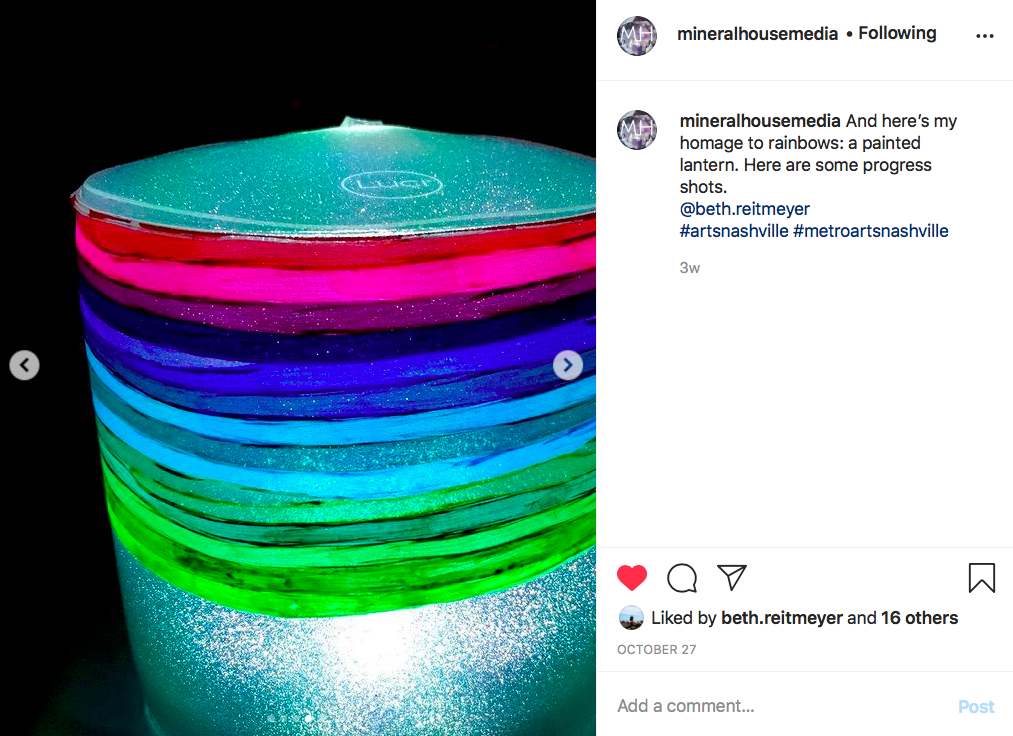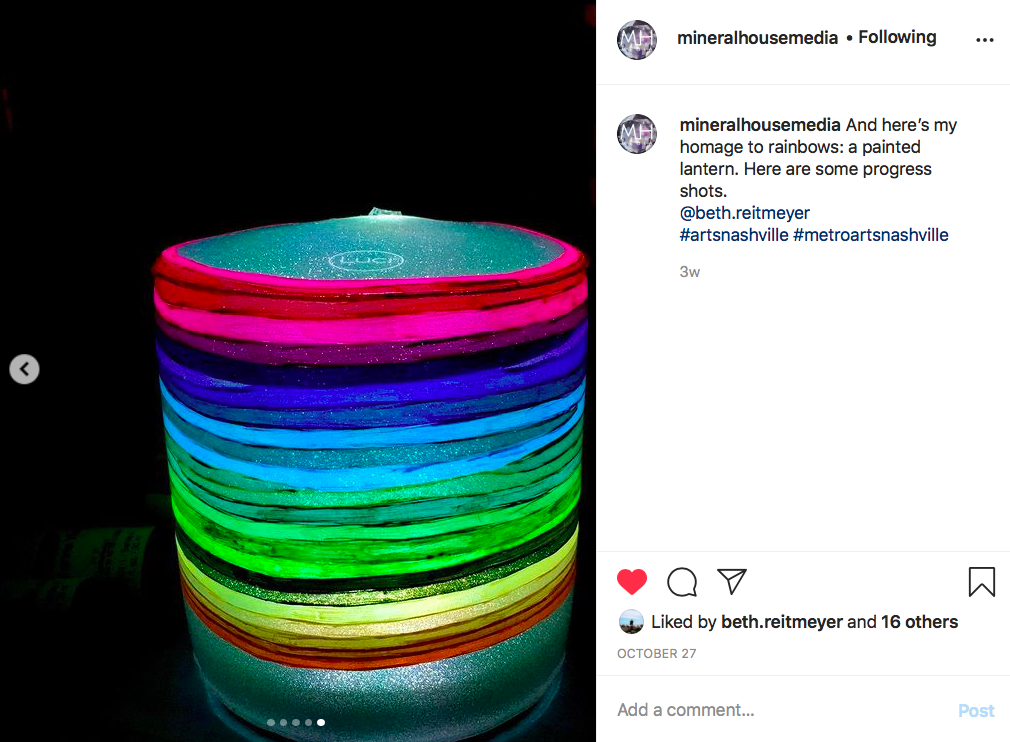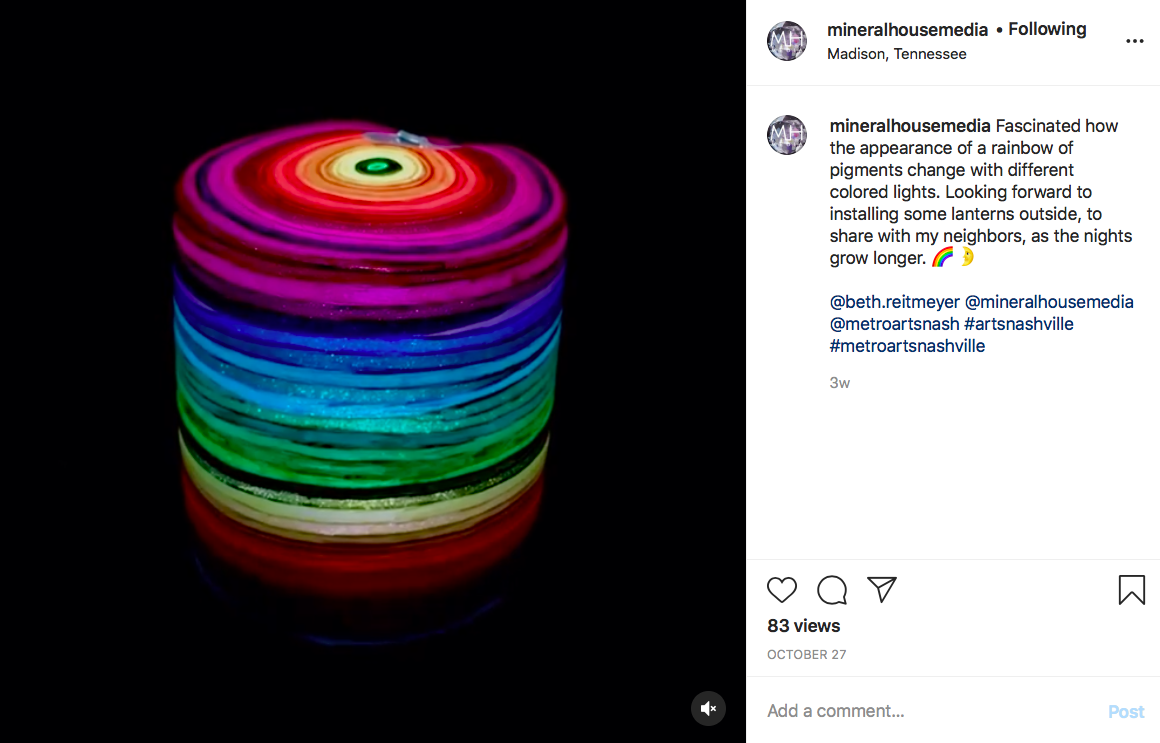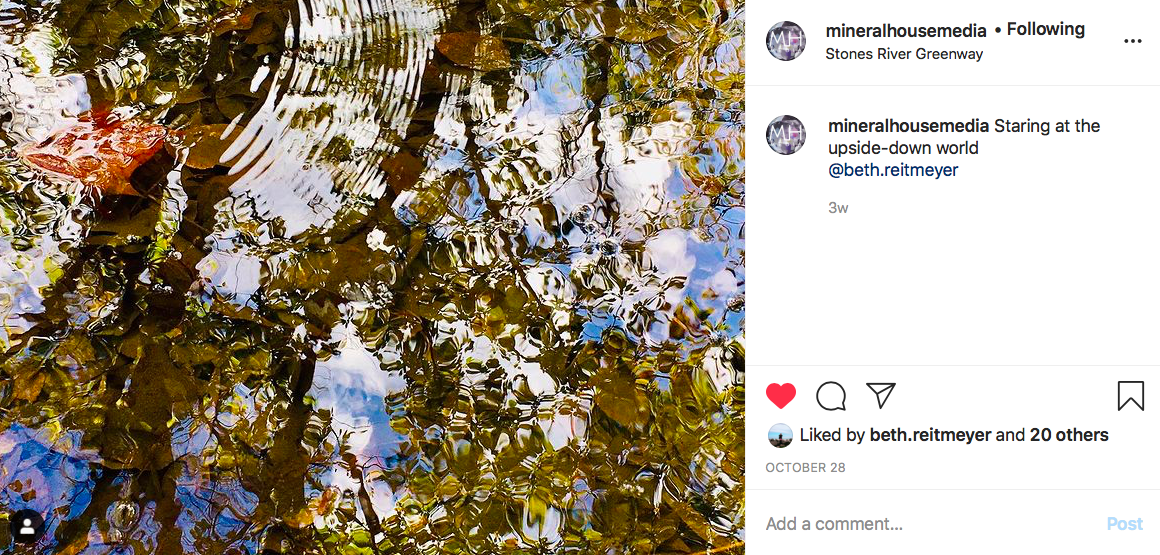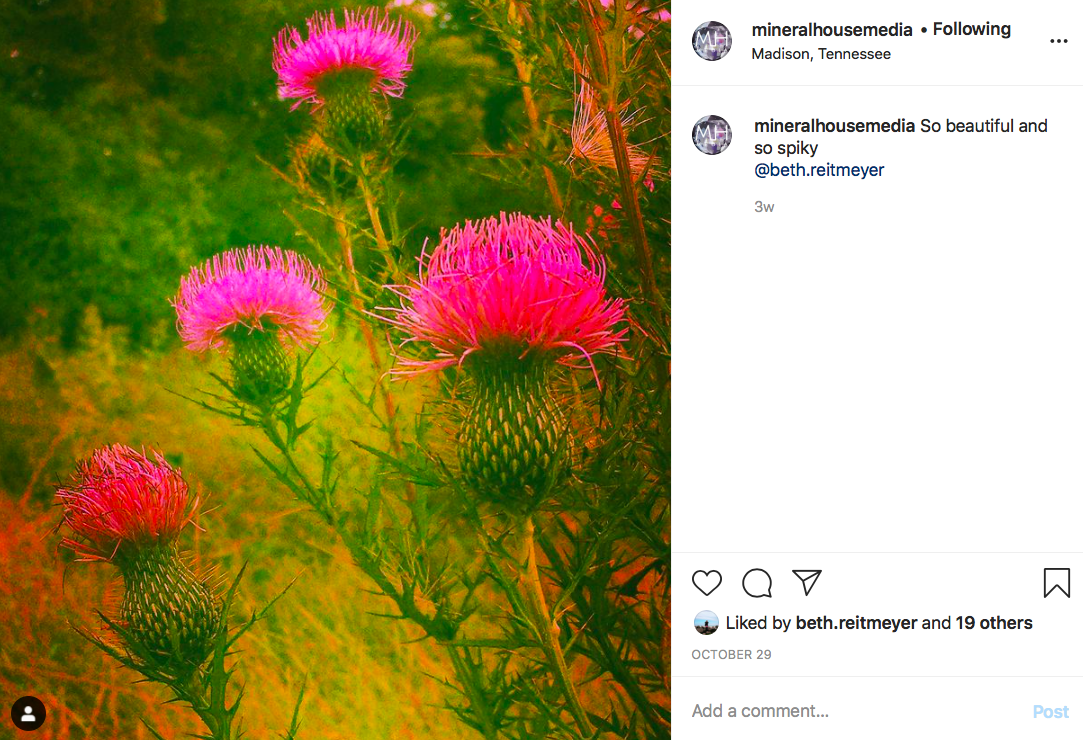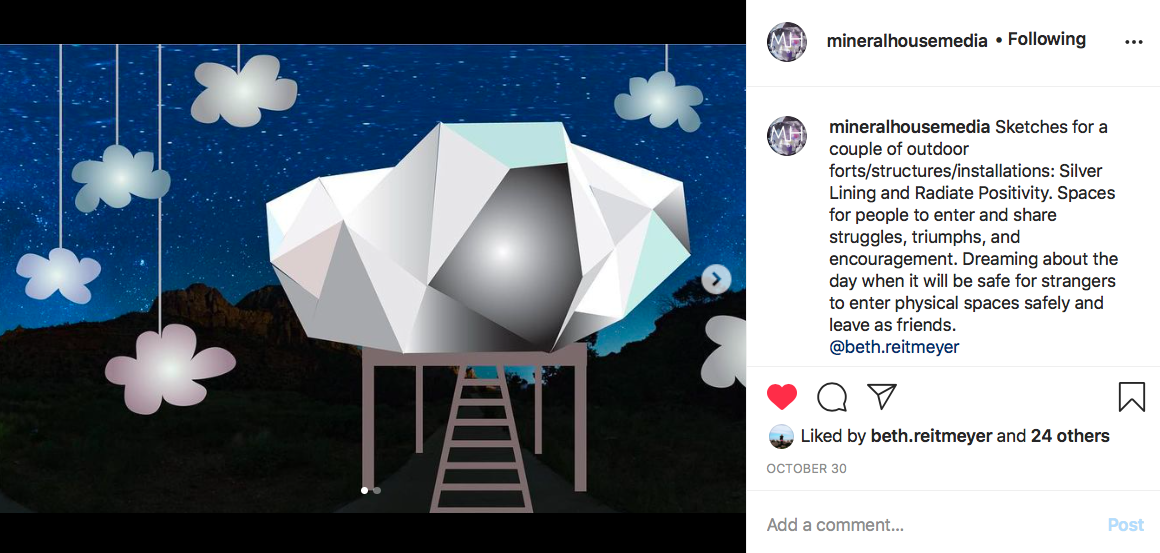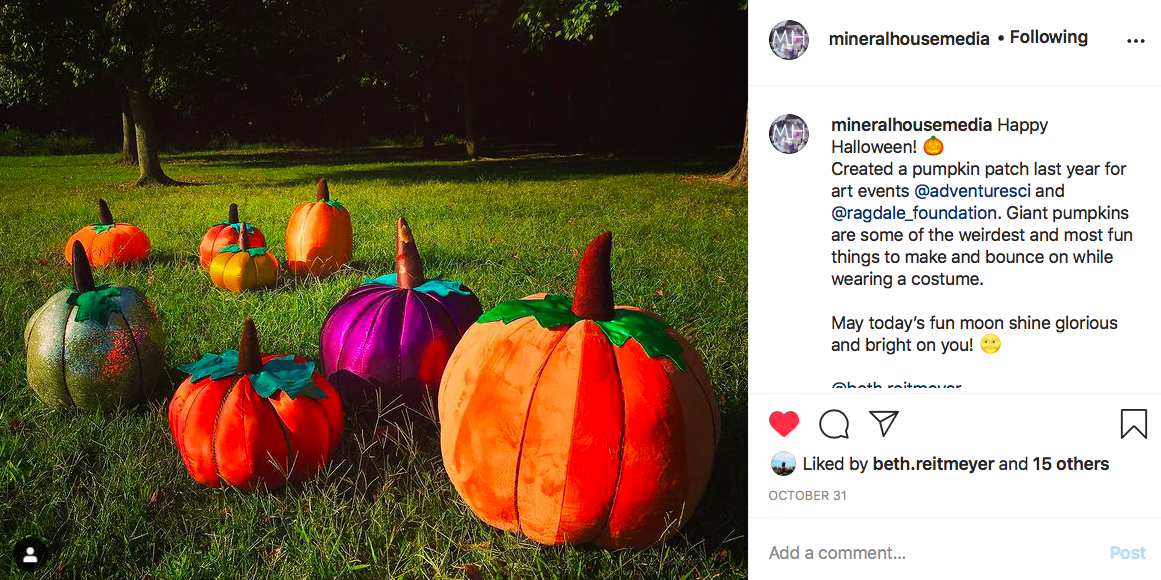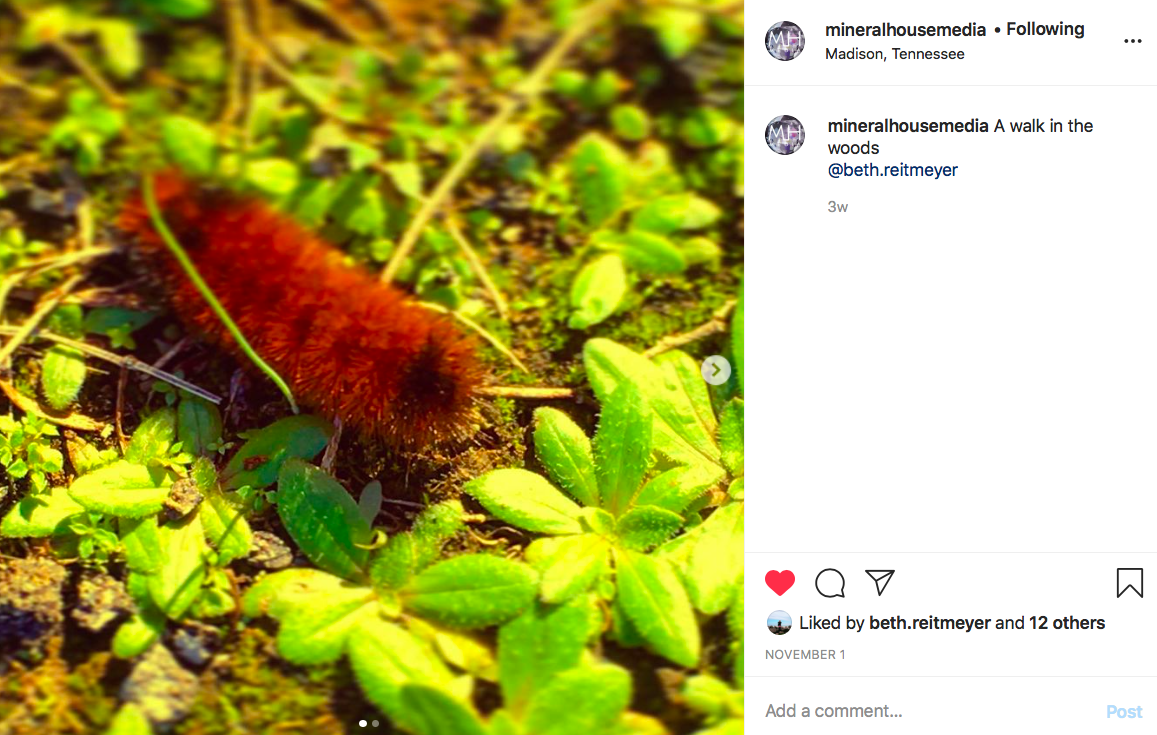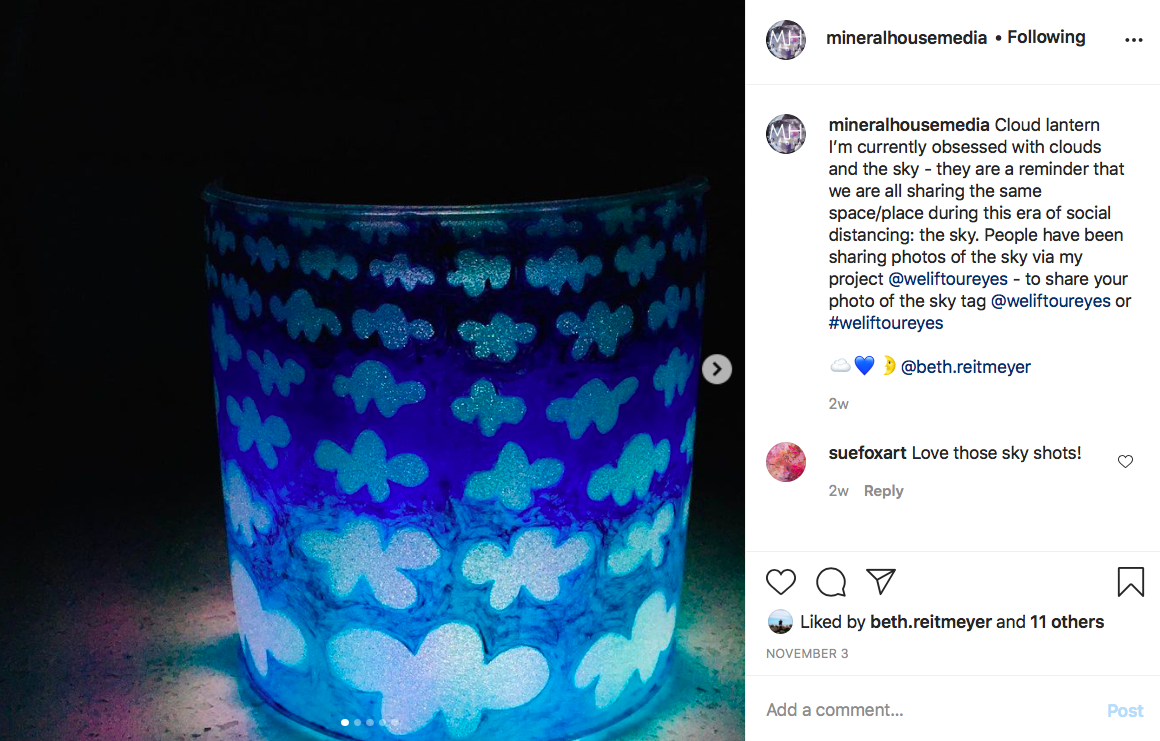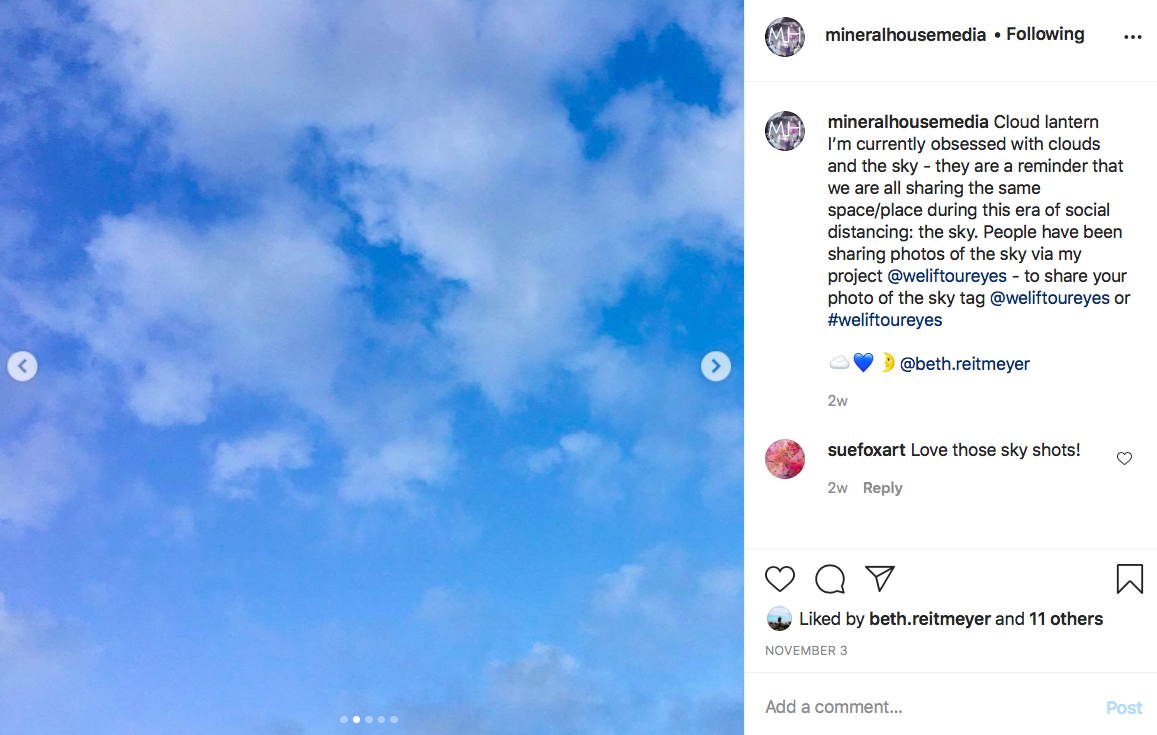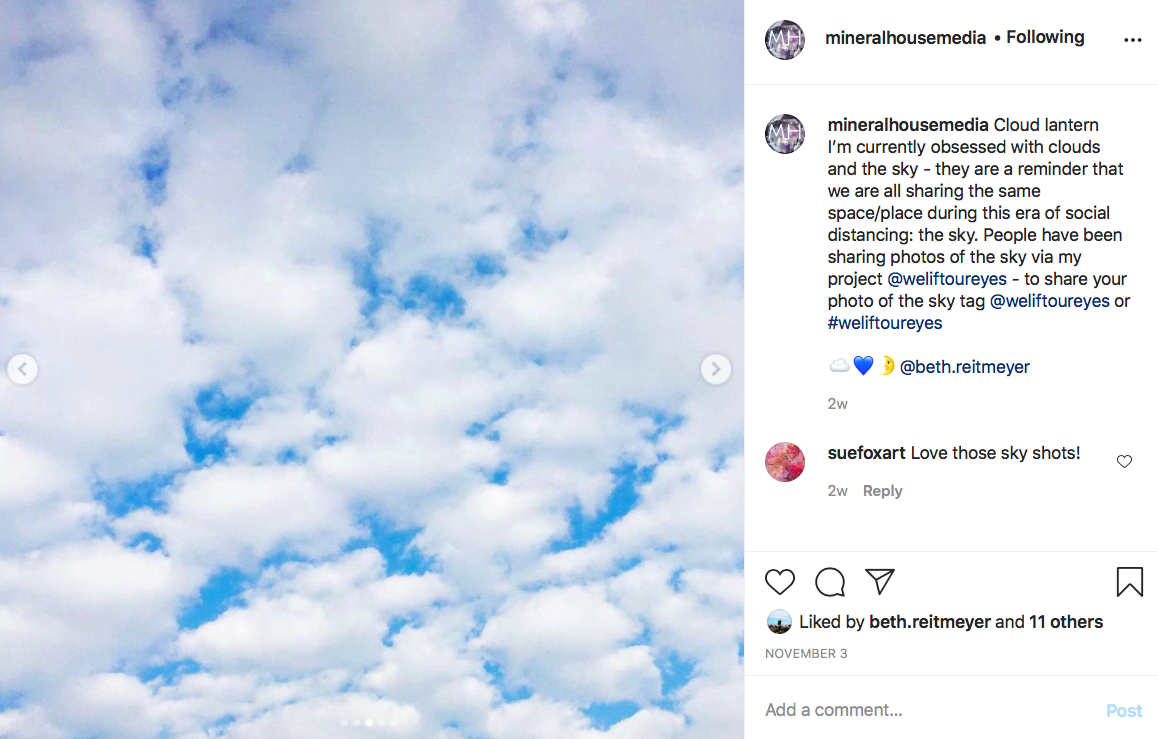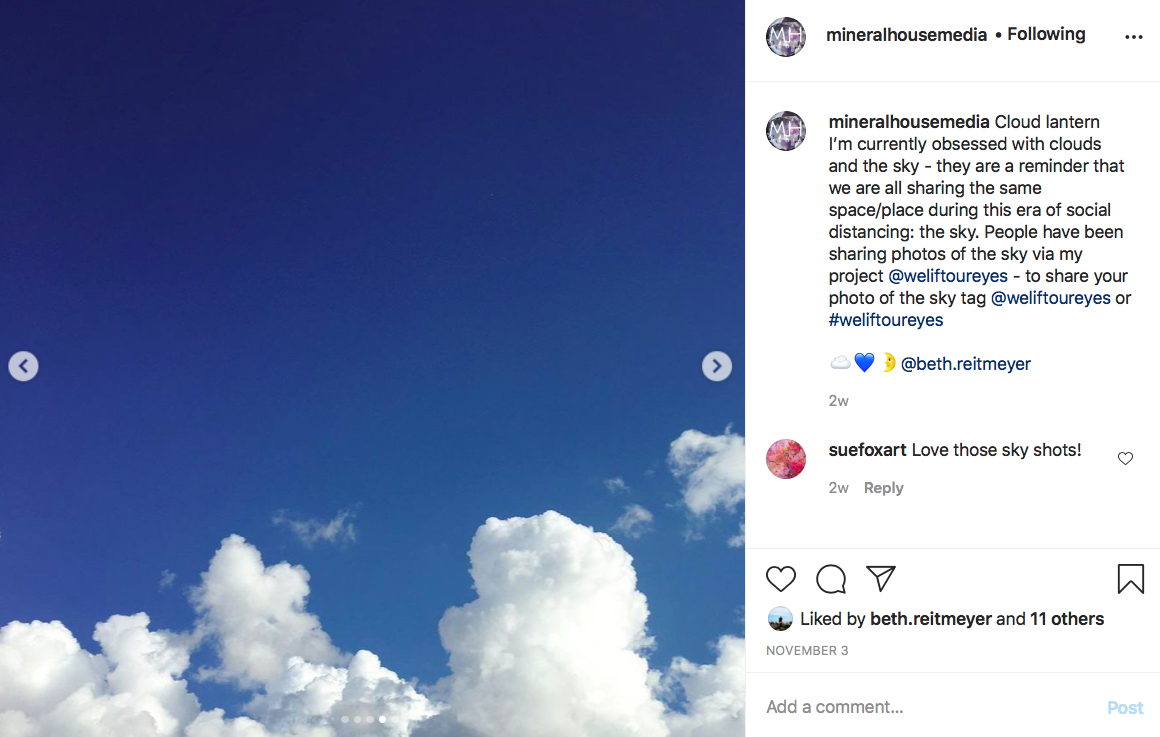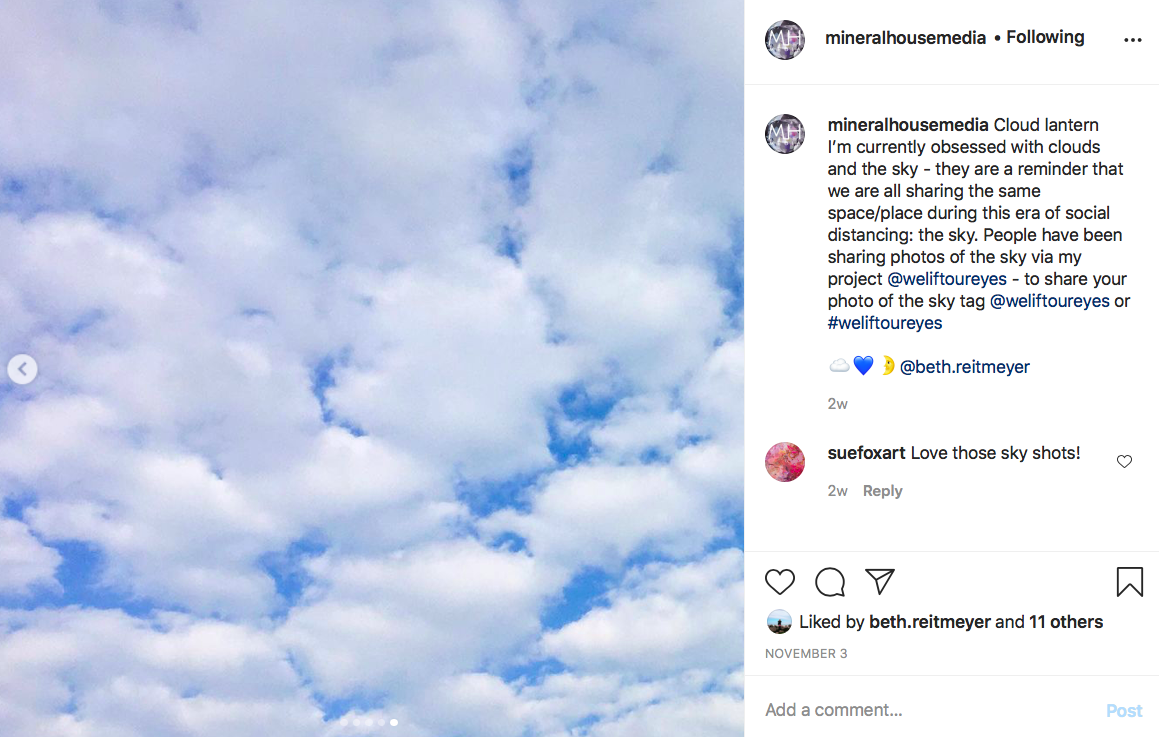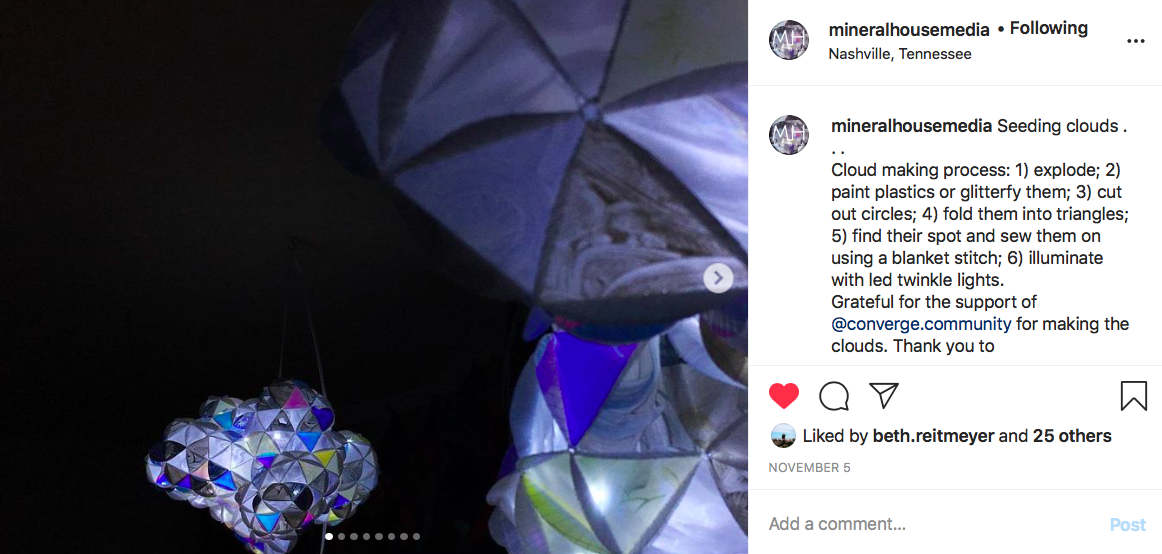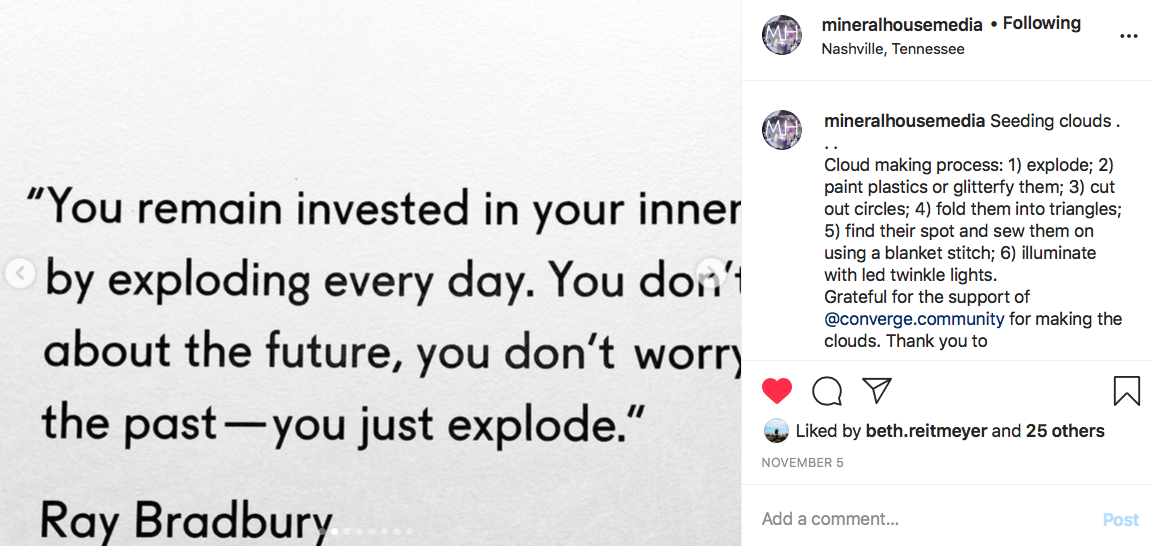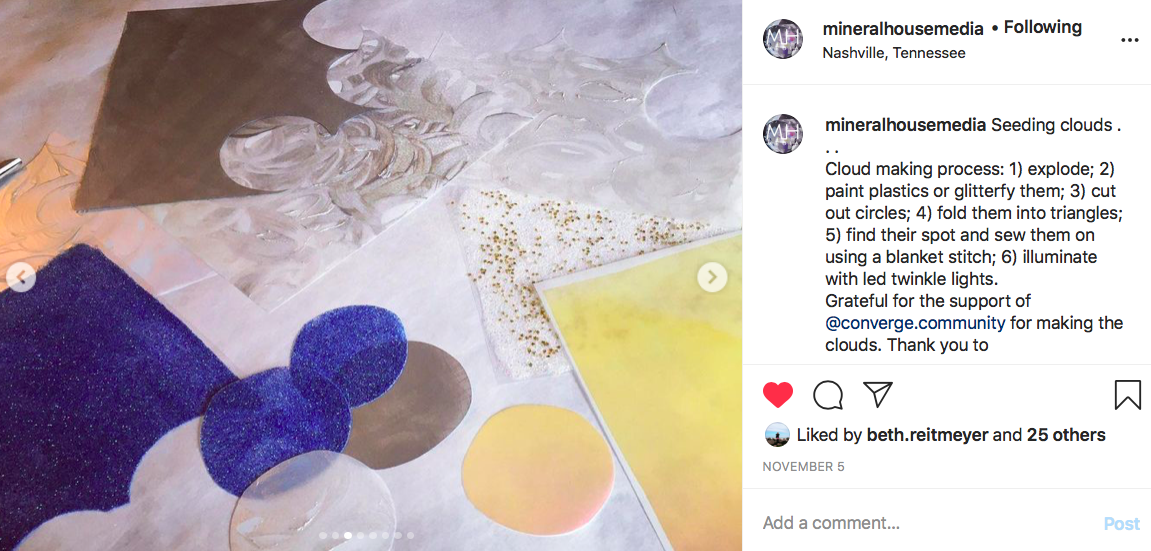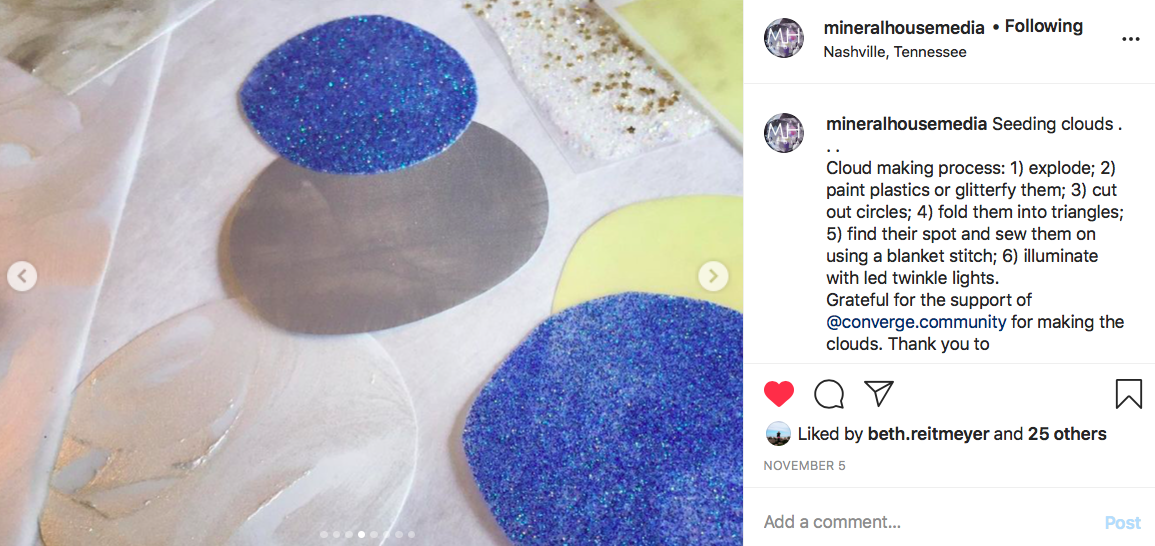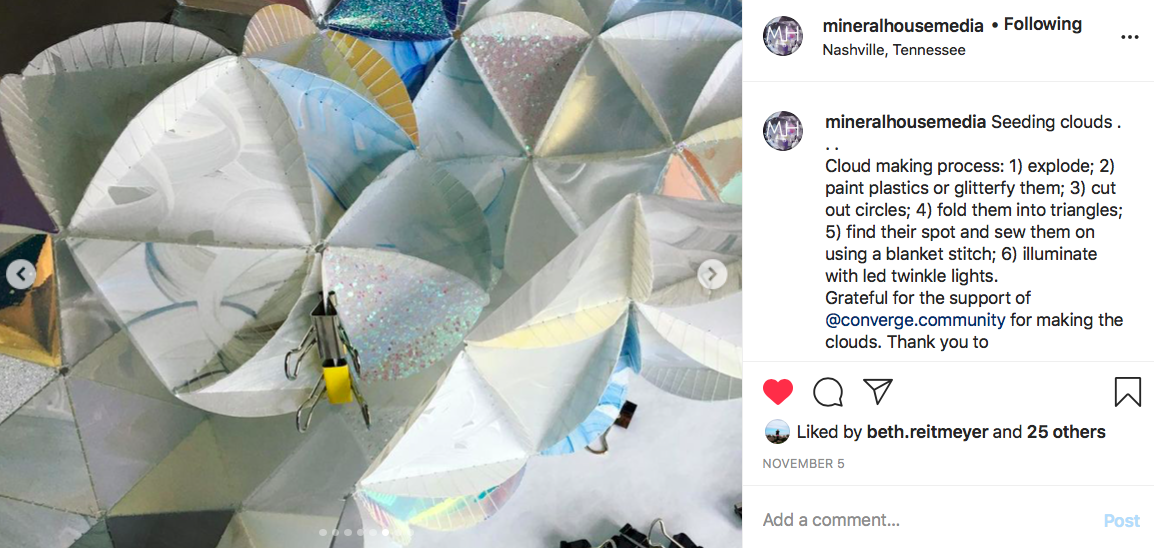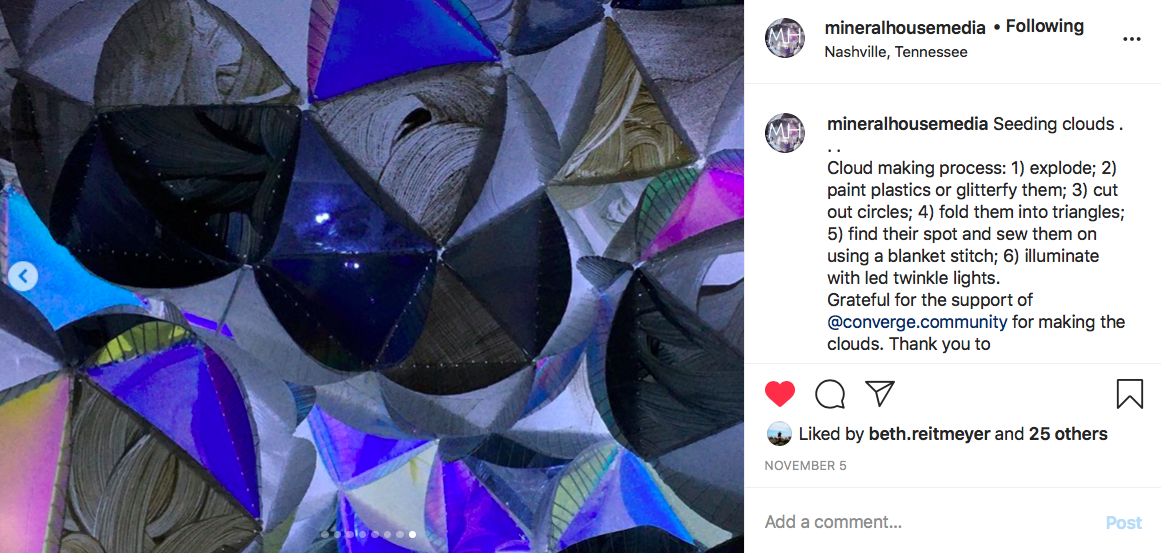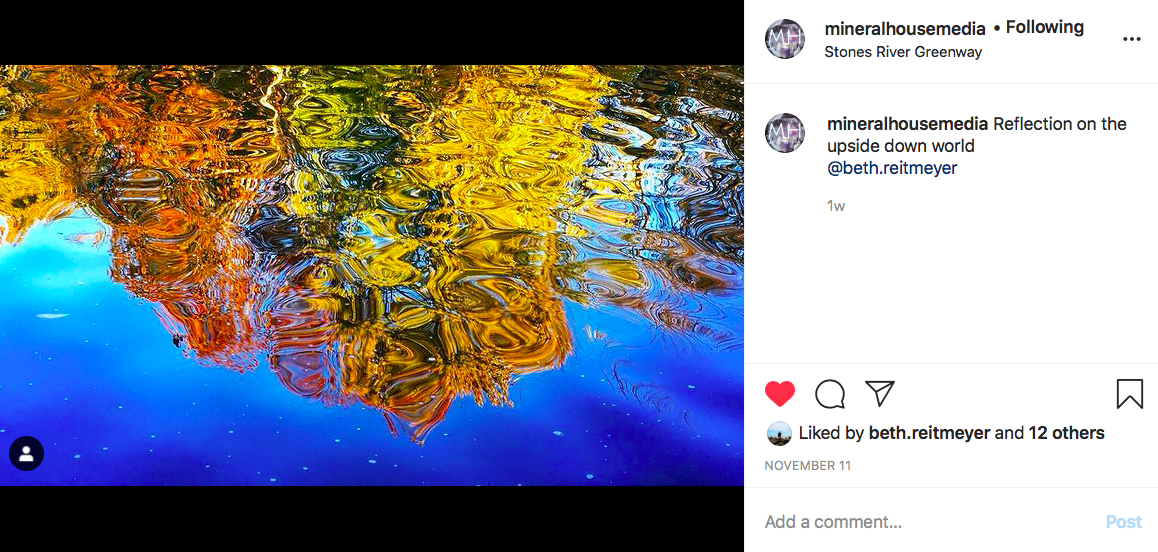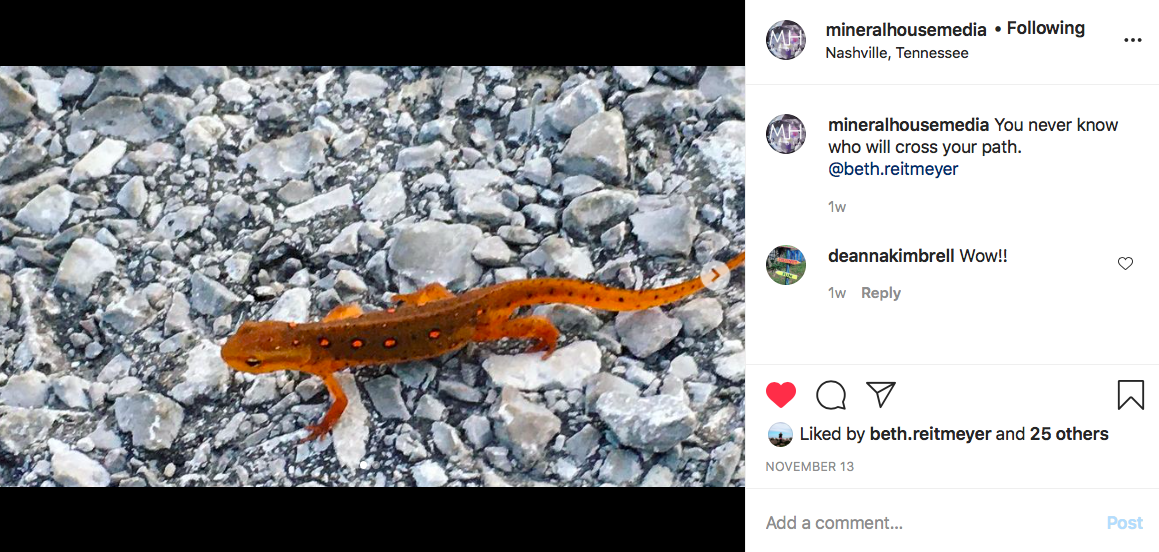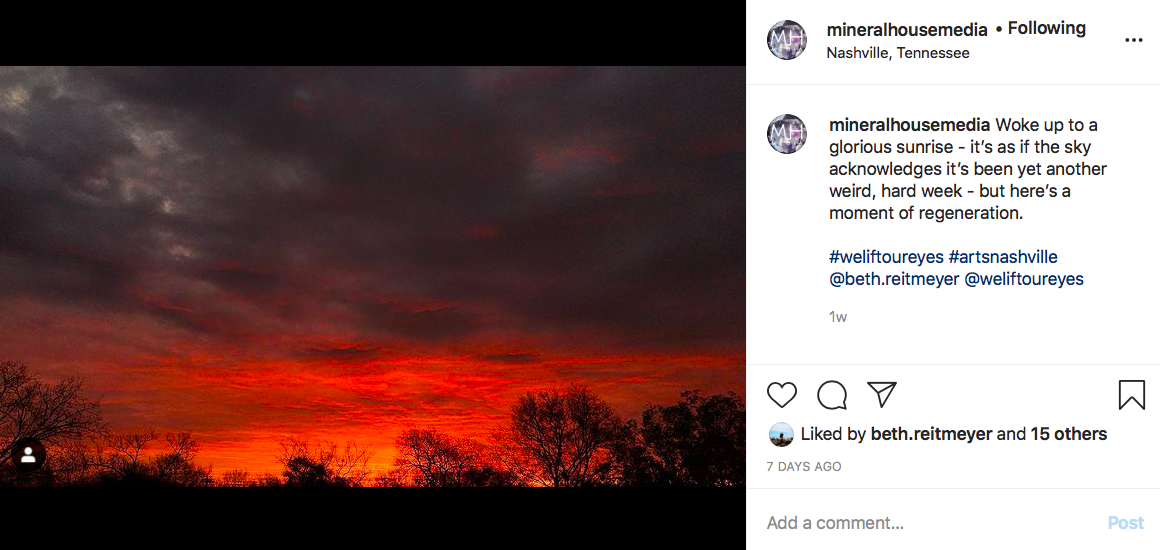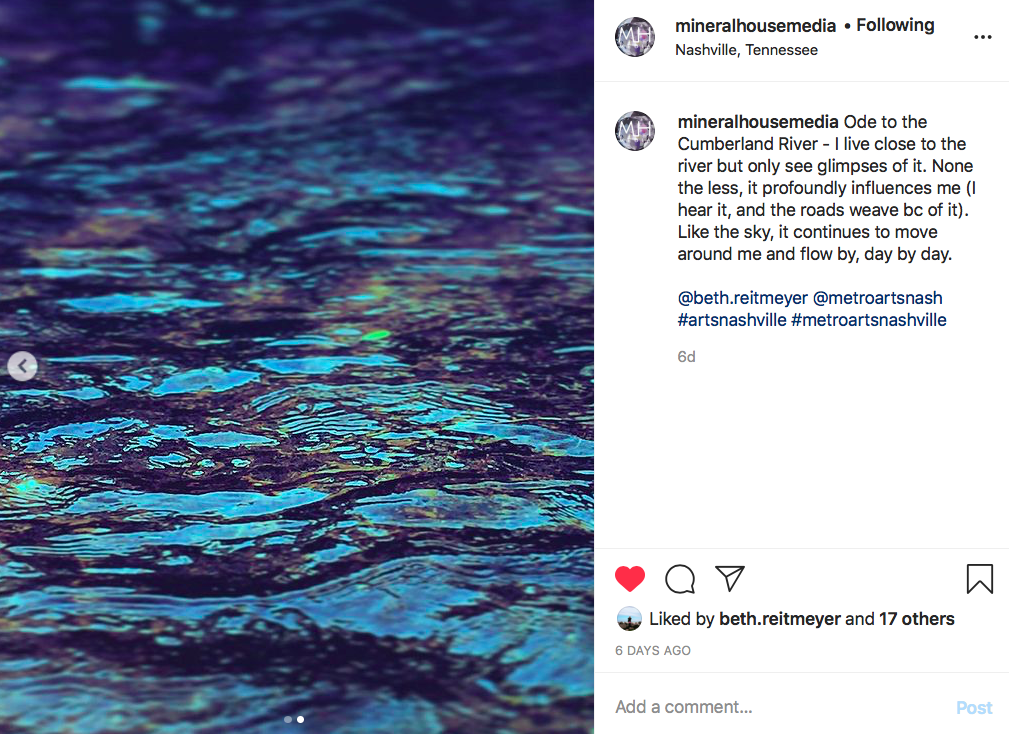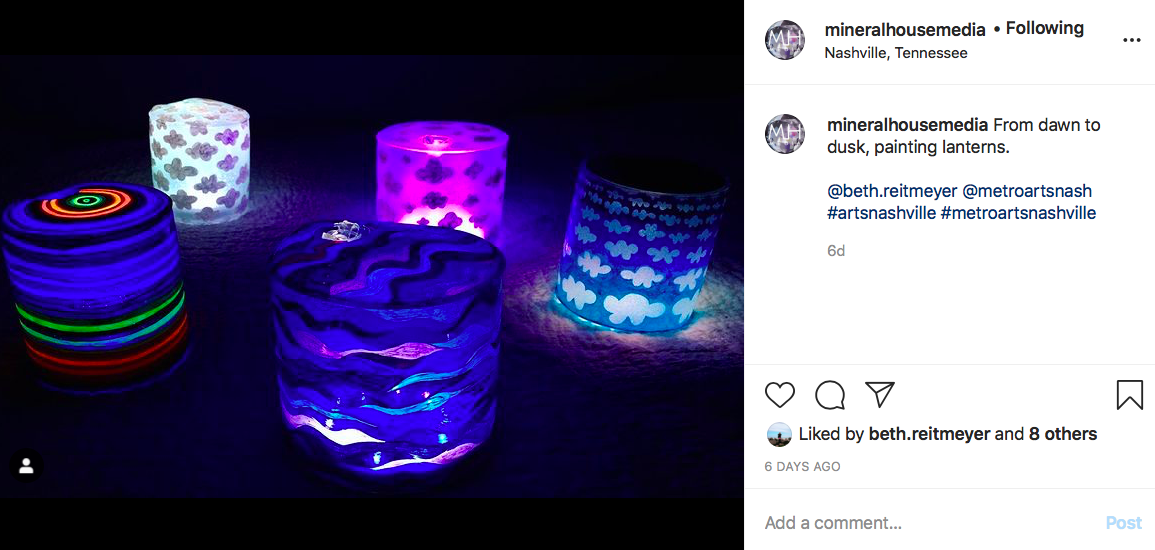Interview with Beth Reitmeyer
Interview with
Beth Reitmeyer
October 2020 Digital Resident
Beth is a visual artist based in Nashville, TN, with an MFA in Art Theory and Practice from Northwestern University and a BFA, concentration Painting and Drawing, from Penn State. She has been an artist-in-residence at the Studios at MASS MoCA and the Ragdale Foundation; her work has recently been exhibited at OZ Arts Nashville, the Frist Art Museum, Virginia Museum of Fine Arts/1708 Gallery, Richmond, VA, Elizabeth Foundation for the Arts, New York, and Zg Gallery, Chicago, IL.
Mineral House Media: What are 5 favorite words that you associate with your work?
Beth Reitmeyer: Fun, interactive, hope, community, light.
MHM: Can you give us some insight into your lineage as a maker? How did you come to create these optimistic environments built around connection, discovery, and delight?
BR: Growing up, my family didn’t have a lot of money. As a child, my sisters and I received one toy on our birthdays and three at Christmas. The rest of the year we made our toys. My mother taught me to sew. She subscribed to Better Homes & Gardens magazine, and I made all of the stuffed animals, crafts, and a lot of the recipes from each issue. My 4th grade teacher put me in charge of her bulletin board, and that was my introduction to interactive/community art. In college, I was trained as a painter. I discovered pattern painters and Feminist artists, including Miriam Shapiro and Judy Chicago. My university mentor told us that most viewers look at a painting for only 30 seconds; we need to figure out how to hold the viewers’ attention for longer. Soon after that, I began to paint on the walls, floors, and ceilings with patterns featuring seasons; on the walls, I installed holiday inspired patterned paintings, which I created to celebrate the holidays over the course of a year. If the viewer turned away from a painting, they experienced more painting. I also installed paintings in places where people sit and stare, such as phone nooks and bathrooms. My current practice is a mix of the joy of making things and having a grand old time — instituting art making practices from childhood — with contemporary art practices and community building. I love to make things; I love to make things with people; I love to share art with others. It’s fun and moving and builds relationships to create and experience art with others.
MHM: You often reference natural phenomena and objects like rivers, geodes, and stars. What does earthen nature and the larger cosmos mean for you?
BR: Land and nature are shared spaces. It’s not something that people can really own. We all move through our place, and it helps form our identity. I’ve lived in quite a few places, and the topography of the place has impacted me. Little bits of nature find their way into my pockets and onto my tables. My friend, printmaker Laura Berman, picks up rocks at each place she visits, and as memory keepers. And I adopted her example and pick up rocks. The rocks in and of themselves aren’t as important as the memories. My car has a little ledge over the glove box, which I call the Pink Gallery. It’s full of rocks picked up from adventures. The other day, my niece picked up a rock comprised of mica with rubies, and I told her about finding it while visiting our cousins in Vermont. I found it on a day while visiting their home in Chester, VT: we chatted outside and picked up chunks of mica from their yard. Often when I ask people if they collect rocks, their eyes light up and they pull one from a pocket or point to one on a shelf. I think, for me, the land and its things give me (and others) the opportunity to assign meaning to things that in and of itself doesn’t have monetary value.
MHM: In using rich, scintillating material and lush color, you invite the observer to interact with your work, and allow them to touch, even enter the spaces. What is the significance of breaking this norm in art, which is often regarded as untouchable?
BR: My art is about the experience, the memory of it, and relationships built and created whilel experiencing it. It embraces radical optimism (everyone can find joy and hope) and indiscriminant hospitality (all are welcome to create and experience joy through sharing). How can art be open, generous, and hospitable if you can’t touch it? Some of it is also about what we value. I’m working to subvert art as a commodity and shift it towards art as generosity and as a gift. During a residency at Anderson Ranch, I met Lewis Hyde. His book, The Gift, inspires me to think about objects as things to be moved from person to person, freely offered, as things I shouldn’t hold onto tightly. My little objects are meant to be touched, cherished, and shared. It’s so moving to have friends under 10 tell me that my stuffed wishing stars or kindness fish are one of the stuffed animals they sleep with. Touching engages another one of the five senses, and experiences are often more impactful when more of the senses are engaged. James K. A. Smith writes about engaging and acknowledging our hearts and souls; he writes that we are not “brains on sticks.” We experience life through our physical bodies.
MHM: There is an element of playfulness in your work. Some objects, made with everyday materials, are lumpy, sweet, or funny, yet are engaged in spectacular display. Do you think humor plays a role in achieving your work’s aims?
BR: Oh yes. Often a piece starts off as a joke. And then I find the joke resonates and makes people smile. For example, some of my current work grew out of me joking that I wanted to make a giant sinkhole. While living in Bowling Green, KY, home of Corvettes, a giant sinkhole opened up in the center of the Corvette Museum, swallowing millions of dollars of cars. I joked I wanted to create a safe sinkhole that people can hang out in and eat snacks. Then I realized I could turn it upside down and make a cave full of snacks. I made the cave, and lots of people spent time in it, eating rock candy and mud pies and chatting. And that cave installation is key to my current interest in the land and place. We need more play and fewer agendas and less pedagogy. Humor builds relationships and helps us acknowledge we’re human. And it’s just plain fun to make and experience.
MHM: What is the role of walking as a meditation or mode of discovery in your practice?
BR: I walk almost every day. Usually I walk in a park near my house, which is at first glance very boring. It’s on the Cumberland River, but most of the year you can’t see it because it is hidden by trees. But every day, as I experience the familiar, I see something new. For example, my park has a cat village with [about] 30 cats, created and maintained by 3–5 people, Today I met an ugly grey cat who is very sweet and needed some love, which made me realize I needed some love, too. Walking gives me a break, it gives me time to process and think, it helps me realize ideas. Some of my strongest artworks have come from walking in my park. The exercise also gives me energy and helps me feel mentally and physically better. It feels like such a luxury to give 1.5 hours to walking every day, but it is essential to keeping me sane and creative.
MHM: How has the lack of social gathering this year impacted your process and visions for your work?
BR: Proposed projects and income shifter and cancelled, which impacted my process and life. I was a finalist for several grants for interactive works, and those grants were cancelled. Some installations are paused. Teaching art classes and workshops were cancelled. I spent a lot of time in March and April scrambling for work. Teaching online brings its challenges (“hold up your art” and “where are you going — come back!”) and/ in person involves a lot of hand sanitizer, masks, 6 feet apart, no shared materials, and sanitizing surfaces and tables. It’s exhausting. Right now I’m working a lot of gigs that may at any point evaporate. In terms of process, it means that I currently have less time to make art, which is ok because I’m working and saving for the future when I’ll have more time. The pieces are within my brain, slowly making their way into reality. I’m called to persevere, working through the exhaustion, loneliness, and waves of new 2020 challenges. Oh, and I’m creating and sharing a lot more digital art, such as my project, @weliftoureyes. We Lift Our Eyes invites people to share photos of the sky as a way to show that we are all still physically connected through a space/place: the sky. I’ve connected to a lot of people via digital communities, and occasionally I wonder if my virtual world and friends are “real.” Life is hard, but there are good things, too.
MHM: You note that in 2020, clouds and storms speak to you as metaphors for our lives. How so?
BR: Each day brings its own weather and skies, and it’s out of our control. But often that’s a good thing — I don’t think I’d do a good job controlling the weather — intense storms are balanced out by gorgeous, sunny days, much like life. I have been thinking about how to create art that gives people permission to talk about a wide range of emotions and experiences, not just happy and joyous ones. My piece, Haunted, invites people to share a name of people they want to remember. People cry and love sharing about people they miss — they are grateful to have permission to share about hard things that they hold close to their hearts. It’s cathartic. And that installation got me thinking that people need space to talk about loss and longing, about how the hardships and struggles may or may not have a silver lining. I started making the clouds in January 2020, exploring them as a metaphor. Soon after, on March 3, a tornado hit Nashville. The storm damage was substantial and disrupted the life of the city. Ten days after that, we shut down for Covid. The hardships of 2020 were very much ushered in by a literal, horrible dark cloud. But throughout the lockdown, the sky has been a comfort and a joy — I have come to appreciate the moments that I give to stop and stare at its beauty.
MHM: Another striking element of your work is the dynamic use of light. How has your relationship with light and materials evolved over time?
BR: I’m fascinated by what people consider beautiful. My young students and friends love twinkle lights, glitter, pompoms, pipe cleaners . . . so some of it is about ideas of beauty and value. Why do we value oil paint over glitter? Most of my lights right now are generated from strings of LED twinkle lights. The light is also a metaphor, a beacon of hope and joy. It’s fun to play with. It’s fun to be able to shift from one reality to another with the flip of a switch or two. Color is also important, and there are magical moments when the pigment color wheel interact with the light color wheel in unpredictable but amazing ways.
MHM: What, to you, is the importance of making art objects when the world is in such a prolonged period of tension and uncertainty?
BR: Making objects is a way to maintain sanity and find joy. I am at my happiest when making things or making things with people. At the beginning of the pandemic, I wondered if I’d give up making things all together or if the pandemic would be like one prolonged artist residency. It has been neither. I fight exhaustion and make for the moments of joy and an act of faith that the pandemic will not squash all that is good.
MHM: If your time and resources were limitless, what would you create?
BR: I’d make a cloud fort structure, one that people can climb into and think about the silver lining to the storms of their lives. I’d learn how to wire and code interactive light and sound structures. I’m aiming to combine sculpture and architecture, to create a structure that is the art and create a building that doesn’t have a practical function. I have a lot of ideas. I dream of the day when I have the time to tinker and work on things.
MHM: In what ways does your practice also influence your personal spaces?
BR: My practice has entirely taken over my personal space. My sister tells me I need more boundaries, but I’ve given up on the boundaries. My home is itself an in-progress installation. Art is life and life is art. Inspired by Ray Bradbury, I explode every day.
“We go through life, looking for hope and love, finding it in expected and unexpected places. My installations create/recreate these kinds of places: investigating clouds, rivers, caves, geodes, stars, and the moon. These spaces are comprised of rich, luscious, inviting materials, such as fabric, glitter, and twinkle lights. Viewers explore the land, finding friendship, space for renewal, and hope for persevering. My work in 2020 focuses on clouds and storms as metaphors for our lives.
My work is influenced by daily walks, and my phone is full of images and video of quirky, beautiful, wonderous things encountered within the landscapes I move through. I am also fascinated by colors, patterns, and structures discovered within my places. For my residency, I will share images of rocks, flowers, clouds, textural dirt, flowing water, snow falling, ice melting, rock formations, wood grain, trees, lights, stars, seeds. I will also share how these influence my installations and my dreams for the kinds of places I’d like us to inhabit in the future.” - Beth Reitmeyer
